 2019-07-16
2019-07-16
.jpg)
![]()
Late Screenings | Kajsa Dahlberg
Rhubaba is delighted to present a screening of Kajsa Dahlberg’s film Reach, Grasp, Move, Position, Apply Force (2014-2015).
For more than a century, film has been used in experiments to understand and optimize our movements. Systems like the Methods–Time Measurement marked a radical shift in attitudes towards manual labour by focusing on the efficiency of human movements. In Reach, Grasp, Move, Position, Apply Force, the production of the video itself is used as a starting point to examine the negotiation of time in labour today: from Amazon warehouses, Apple manufacturers in China to smaller-scale service industries such as freelance translating and parcel delivery. In this sense the film reveals its own working conditions. But it is also about the relation to time in film and hence about the negotiation between the audience and the film itself.
The screening will take place after the second session of Automatic for the People, a reading group on the hopes and struggles of technology. You do not have to attend the reading group to come along to the screening. This event is free and non-ticketed, refreshments and popcorn will be provided.
This screening is the first of a series as part of Rhubaba's Late Screening Programme. Each evening will explore a different theme, selected by Rhubaba committee members over the next six months. Information about the forthcoming screenings will be announced soon.
Image credit: Film still from Reach, Grasp, Move, Position, Apply Force, 2015; 40 minutes, HD Video, 16:9.
More information:
http://www.rhubaba.org/kajsa-dahlberg/
More about Automatic for the People reading group:
2019-02-20
Non-linear Narrative Structures: The Dramaturgy of the Spiral
The Art Academy is pleased to announce the first of two events focusing on non-linear narrative structures. Co-organised by artist Kajsa Dahlberg and Associate Professor Lisa Rosendahl, the first session will feature a lecture by Gender Studies scholar Ingvil Hellstrand and a screening of a new film by Dahlberg made in collaboration with Gritt Uldall-Jessen.
Time: Wednesday February 20, 6.00 - 9.00 pm.
Place: Prosjekttorget (ask the reception for directions), Oslo National Academy of the Arts, Fossveien 24.
This event will be held in English.
The understanding of time as linear and progressive has been central to the development and self-image of European modernity stretching back to imperialism. This way of perceiving and telling about the world has enabled humans to believe, experience, and describe interconnected things as if they were separate, resulting in the normalisation of an ever expanding exploitation of life, labour and the environment.
How can we develop a sensitivity to other, human and more-than-human, temporalities? How might they change the way we relate to each other and the world? What kind of alternative narrative structures can make room for stories that are sorely needed but not yet available?
The evening will be preceded by a separately announced workshop for Art Academy students exploring how non-linear spatial constructs might affect relations of knowledge production.
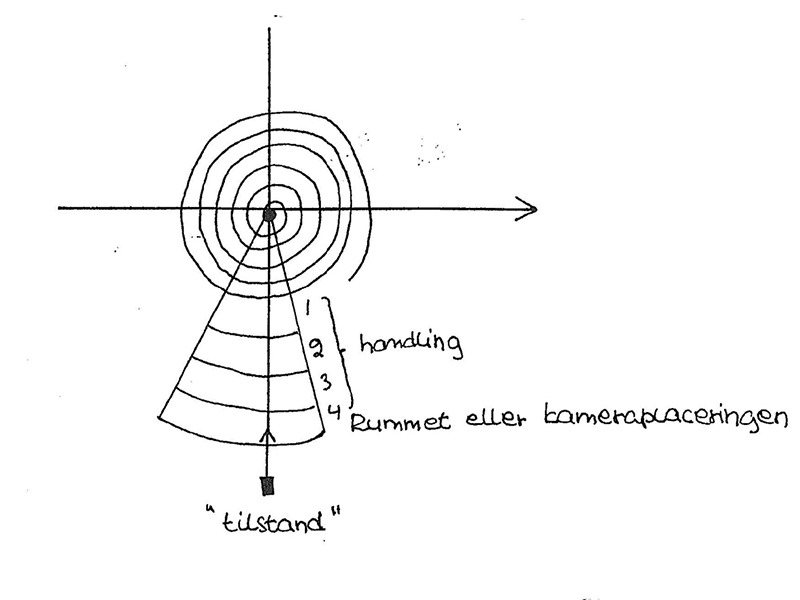
![]()
2017-09-09
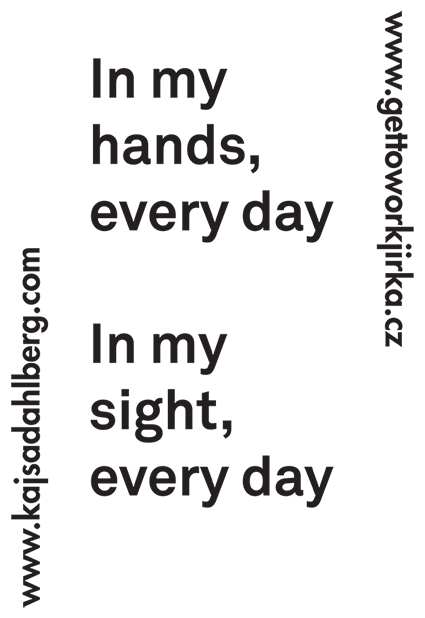
![]()
In my hands, every day; in my sight every day
Kajsa Dahlberg & Jirka Skála
curated by Laura Amann
9.9.- 27.10.2017
part of Fotograf Festival #7 Eye in the Sky
https://fotografestival.cz/2017/in-the-sky/
www.gettoworkjirka.cz
www.kajsadahlberg.com
“Australia fights sharks with drones - Algorithm spots sharks on aerial images taken by drones”
“Several arrests at demonstration against Online censorship in Russia - Demonstrators lament increase control of the web through government”
“Facebook knows family secret: Algorithm shocks user - Father of US-journalist was adopted, Facebook suggested unknown relatives as friends without apparent reason”
Headlines of derStandard.at on the authors Facebook feed on the 27th of August 12:41-12:43pm
“The modern machine…possesses its own laws of pulsation, functioning, and relaxation — laws that do not stand in conformity with the rhythm of the human organism. The world of the machine, the world of mechanical equipment and urbanized labor, produces specially connected collectives, begets certain types of people. These are people who we must accept, just as we accept the machine, though we must not smash their heads on its gears. We must bring some kind of equalizing coefficient into the machine’s iron disciplinary pressure, though history insistently demands we pose these not as petty problems of the social protection of the individual personality, but rather the bold engineering of human psychology according to such an historical factor as machinism.”
Aleksei Gastev
Method Time Measurement (MTM) was developed shortly after WWII with the aim to rationalize and optimize all movements and motions needed to perform manual labour. The process involves analyzing motions, describing them and assigning them ideal duration times. From 10 basic categories 1600 subcategories were defined. The assigned times are supposed to be representative for an experienced worker under normal circumstances. It takes around 2000 cycles until an MTM measurement becomes standard. MTM is consequently also used to predict and expect task times of complete production cycles. But evidence shows that reality and theory don’t agree as the system relies on analyst judgement and results may not reflect on the accuracy of the work done.This did not prevent MTM becoming a popular and widespread tool to increase productivity in labour.
MTM is a process much in line with earlier developments of scientific management, automation and mechanization such as Taylorism and Fordism. It is easy to see early forms in the enthusiastic appropriation and application of mechanization processes in Soviet Taylorism. Aleksei Gastev, poet and factory worker was a passionate promoter of ‘systematic planning’, ‘chronometration of time’ and ‘automated uniformity of labor’, pushing his vision of assembly-line production and rationalization so far as to make Fords theories compatible with Karl Marx’ thinking. As the founder and first director of the ‘Central Institute of Labor’ (1920-1937) he was also instrumental in the Constructivist’s artistic and architectural appropriation of Taylorism, since his distinct interpretation lent itself to modernist aesthetics and it was his fanatical promotion that paved the way for the embrace of the machine cult by the Soviets.
It is notable that Gastev had very well understood that mechanization basically meant the mechanization of man himself and that this process had to go so far as to encompass his so-called mental activity basically even if it this meant going against human nature.
Psychophysiology and Psychotechnics, a much revered and adopted discipline within Taylorism, were exactly trying to achieve this reprogrammation of the human mind. In short Psychotechnics is defined as a scientific theory aiming to seize and subordinate the mind and artificially control behavior. The discipline researched in an experimental manner a variety of problems also related to aesthetics, such as the balance of simple shapes,symmetry, repetition of spatial forms, rhythm and rhyme, impression of the poetic language elements, the conditions of uniform appearance and so on. Ultimately it served as a further tool to achieve the mechanization of the human as Gastev had demanded, to reach not only physiological perfection but also the adjustment of mind and behaviour to the needs of machines.
Very much opposed to the enthusiastic adoption of scientific management, the cult of machines and the great hopes for improvement of labourers lives through less working hours, better payment and more time for intellectual and artistic labour in the Communist context was the reception or anticipation of mechanization in the Western countries. The introduction of machines was received with a great amount of anxiety and fear of replacement and obsoleteness by the workers. Additionally it was very soon clear that the improvement of efficiency through machines within the system of Capitalism would only serve to further exploit and oppress workers while increasing profit on their backs.
This structure of feeling sounds actually all to familiar if we think about contemporary sentiments towards labour market and its current or anticipated developments. The rapid evolution of new technology, robotic systems, artificial intelligence and all possible cross pollinations of these have many a professional worried about the close future in their respective disciplines - except now this does not only concern workers, but also academically trained people.
Similarly if the methods of scientific management entailed measuring the ‘ideal’ movements of workers (be it physically or mentally) to increase efficiency and profit or leisure time (depending on political context or vision) nowadays we see all of our data mined and extracted to the maximum as data has become the most valuable capital in a digitally dominated world and going full circle in the newest developments that have seen tech giants invest in physical stores to further increase the surveillance and extraction of information through tracking of offline movement and behaviour.
The death of capitalism has been announced many a time, but each step seemingly closer to collapse we have seen it mutate into a harsher and more merciless monstrum - so in what kind of Capitalism are we currently living?
In an attempt to define exactly this Nick Srnicek describes the current state of prevailing economy as Platform Capitalism. So from the Fordist model of mass production and mass consumption we went a Post Fordist model that saw flexible production, the individualization of products, responsiveness to consumer preferences and outsourcing of non profitable sectors at its core and money was to be made mainly through branding.
Parallelly we went from life-long careers to jobs, arriving to a rhythm of employment from gig to gig.
Platform Capitalism on the other hand operates with intermediaries and offering of infrastructures. The main revenue streams within these structures consist of advertisement, cloud computing, products and sharing economies. The strategies applied lead to monopolization through network effects (just think how hard it is to escape companies such as Facebook or Google in one way or the other), cross subsidization where companies offer services for free to get more people on board and raising prices on other items to make profit and ultimately they all come with a built in architecture that does not allow for neutral unmonitored exchange but requires adherence to specific rules of behaviour, manipulating its users.
The key resource being data platforms become constantly improving aparatuses to extract data across alls
economies. To expand their activities in data collection the infringe on privacy, ask for ever more personal
information and gather data through wifi networks and the like turning all our activity not only labour and
consumption into profit but even leisure, idleness or sleep while ever increasing this effect through constant manipulation with the same means.
Again we can argue that the discourse is evolving between two very disparate visions, on the one hand those who see the digital as a means to liberate the human, free up time for leisure or intellectual activity, increase salaries and therefore break down hierarchies, decentralize control and possibly even help harmonize social relations and on the other hand those who see the increased omnipotence of technology as the ultimate tool to further oppress and exploit, increasing the power, surveillance capabilities and wealth of the ruling class. We might agree that currently the latter scenario seems significantly closer to our reality, indicating that without changes to the underlying framework it is not likely that technology will radically improve the lives of the masses - we are left to wonder how to possibly move towards the first?
Laura Amann, 2017
Kajsa Dahlberg (born 1973 in Göteborg) is a visual artist based in Stockholm and Oslo. Her works interrogate the content and subtexts of different medial forms of expression: How are collective and individual narratives intertwined? How do political representation, historical discourse and the formation of individual identity interact? And what is the role of the respective medium? The newly created work - - - shown at Hunt Kastner is the first in an ongoing project and questions the shift of focus from production to distribution and circulation of content through the internet. By using one medium to capture another, a document is created that can only be watched as an event in time and potentially would have been very different if recorded minutes later. Simultaneously it relates to the genesis of data of ourselves through leisurely activities which yet again will reappear on our screens as the algorithm learns about our interests and habits. Dahlberg addresses the issue of a sense of loss of future which can only be regained by once again relating to a more humane temporality. Dahlbergs work has been shown in biennials and group exhibitions such as…
Jirka Skála (born 1976 in Sušice) is a visual artist based in Prague. His work is close to the tradition of postconceptual art and participative art, these tendencies being reflected through the mediums of text, performance, installation, photography and videos. Earlier works thematised the textual narrative and alternative modes of communication, later he investigated the duality of socially and privately determined relations to consumer productions by means of work or leisure resources. Deepening his research in this field, for this exhibition Skála dissects his personal archive in form of an external hard disk, revealing not only his working structure but also his physical relationship to this familiar object and realizations of the conditions his artistic practice operates from. Skála presented his works in a variety of international show such GNS at the Palais de Tokyo in Paris in 2003, I, an exhibition in 3 acts at Secession in Vienna in 2006, 25 Years Later: Welcome to Art in General at the UBS Art Gallery in New York in 2007, The Other Tradition at Wiels in Brussels in 2011, A Plea For Tenderness at Seventeen Gallery in London in 2012, Manifesta 11 in Zurich in 2016 and in personal shows such Hygiene at Display Gallery in Prague in 2002, Exchange of Handwriting at Art in General in New York in 2006, Two Families of Objects at Hunt Kastner Gallery in Prague in 2007, You are Object, I am the Impulse at Gallery of Vaclav Spala in Prague in 2010, Third Family of Objects And Confrontational Reading at Hunt Kastner Gallery in Prague in 2012, Jabberwocky at Foksal Gallery in Warsaw in 2014, and finally Playfield, Documents Free time, Unpaid work, recreation and idlness atEtc Gallery in Prague in 2016. He received Jindrich Chalupecky Award in 2009.
Letter to coworkers / Instructions for an undirected film, Log # 2:
A person born in 1993 or later who will generate the content of the film and be the filmmaker (1).
A person who can run a 16mm camera.
A 16mm camera to be used for the recording. No sound.
A 16mm color film wheel long enough to generate about 10-11 minutes of finished material (2).
A computer connected to the internet. Preferable as large a computer screen as possible, but not a projection.
The camera will be placed facing the computer monitor with the viewfinder covering the entire screen, but not the machine itself or the people operating it. The image will be static and the film shot in a single take.
The browsing session should not be planned or thought through. For the duration of one single take the person born in 1993 or later will take us through images, texts, news, social media, forums, emails, chats and videos, with the ease of doing what one always does, like a flâneur walking the streets of a city center, using the web browser of their choice.
Mark the exposed film with your (internet user) name, location, date and time of filming and send it off to the lab.
Kajsa Dahlberg, 2017
(1) Access to computers and to the internet is of course not something that is equally distributed or available to all, and I want stress that this person doesn’t have to be a frequent computer or internet user, only born into the world at a time when these technologies were already existing and available.
(2) For instance, Kodak 16mm Color Negative Film (122m) 7207/250D
Art Practice and Other Activities
Free Time
Idleness
Organised Education
Procrastination
Recreation
Salaried Work
Sleep
Unsalaried Work
Jirka Skála, 2017
#1 Take measurements of all surfaces in space.
#2 Build 3D model in Rhinoceros 5.0.
#3 Cmd: SelectSurfaces//UnrollSurfaces//Explode
#4 Cmd: DuplicateBorder
#5 Cmd: Export [AI]
#6 Save As Scalable Vector Graphics
#7 Run genetic nesting algorithm [a method for solving both constrained and unconstrained optimization
problems that is based on natural selection and repeatedly modifies a population of individual solutions]
#8 Stop nesting algorithm at maximum material utilization [18 iterations; 56/56 parts placed]
#9 Import in Rhinoceros 5.0
#10 Placement of 16 objects distributed in equal distance to perimeters and each other on nested gallery
surfaces
Also see the PDF here
2016-10-21
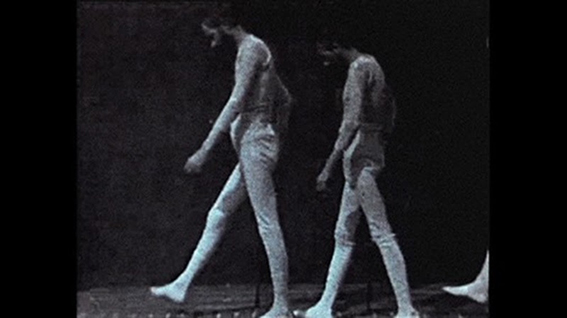 Kajsa Dahlberg: Still from Reach, Grasp, Move, Position, Apply Force (2015). Photo is from The British Universities Film & Video Council.
Kajsa Dahlberg: Still from Reach, Grasp, Move, Position, Apply Force (2015). Photo is from The British Universities Film & Video Council.![]()
Art conversations, October 21, 2016
As a part of Kunsthall Trondheim's opening programme, we welcome you to art conversations.
This evening the artists Kajsa Dahlberg, Claire Fontaine, A K Dolven and VALIE EXPORT will
discuss their respective artistic practices and works in the opening exhibition
this is a political
(painting) with guests. A K Dolven will do a performance, and Alexandra Pirici's work Monument
to Work will be performed after the art conversations.
4 – 5pm Kajsa Dahlberg in conversation with Mike Sperlinger
5 – 6pm Claire Fontaine in conversation with Giovanna Zapperi
6 – 6.30pm Performance, A K Dolven
6.30 – 7.30pm A K Dolven in conversation with Helena Holmberg
7.30 – 8.30 VALIE EXPORT in conversation with Yilmaz Dziewior
9 – 10pm Alexandra Pirici, Monument to Work
The art conversations will be held in English.
Read about the conversation partners
Kunsthall Trondheim
Kongens gate 2
7011 Trondheim, Norway
2016-10-20
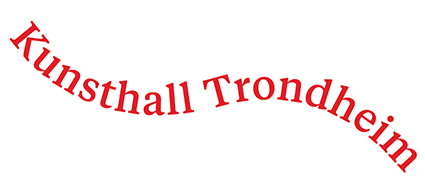
![]() this is a political (painting)
this is a political (painting)
Kajsa Dahlberg, A K Dolven,
VALIE EXPORT, Claire Fontaine and Alexandra Pirici
October 20, 2016 – February 26, 2017
Kunsthall Trondheim are proud to inaugurate our new permanent space
with the exhibition
this is a political (painting), presenting work by
Kajsa Dahlberg (Sweden), A K Dolven (Norway), VALIE EXPORT (Austria),
Claire Fontaine (France) and Alexandra Pirici (Romania).
The exhibition takes its title from A K Dolven's work this is a political painting (2013).
The artist has filled the surface of the painting with her fingerprints in a long repetitive
pattern – lines of red marks, as a text without language. The prints are fading out when
the red ink wears off the finger, still the movement insistently continues, as if the body
persists to remind of its existence – its place and conditions in society, the identity it
carries, its relation to work and how language, or the lack of it, sets the boundaries for
its potentials. The body is the place where the individual meets the society and has to
negotiate its existence – therefore the body is political as is A K Dolven's painting and
the other works in the exhibition.
Read more
Kunsthall Trondheim
Kongens gate 2
7011 Trondheim, Norway
2016-09-24
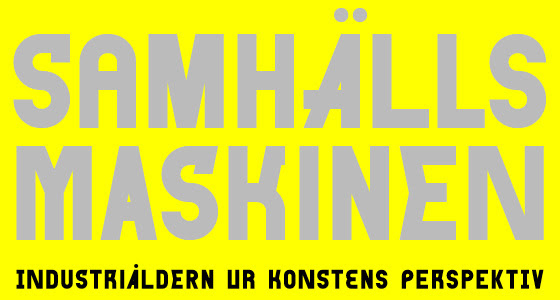
![]() Samhällsmaskinen
Samhällsmaskinen
Malmö Art Museum
The Industrial Age from the Perspective of Art
24 September 2016–15 January 2017
The
Society Machine examines the image of contemporary Sweden, beginning with industrialization, the cultural transformation which served as the foundation for the world-famous Swedish welfare state. Works by approximately thirty artists are exhibited in dialogue with objects from Malmö Museer's historic collections. Together, they portray a society fundamentally changed, today in the midst of its next large-scale transformation.
The term industry is used in the exhibition as a prism through which different images of society become visible. From Malmberget in the north to the limestone quarries in the south, we are confronted with clear-cut forests, slag heaps and prefabricated housing units. Industrialization cleared the way for mine shafts and factories, but also for more existential sink holes. Furthermore, the exhibition sheds light on how art has been inspired by the aesthetic possibilities and materials of the industrial age, which time and again have challenged the limits of art.
The modern Swedish welfare state was made possible through a trade-off: industrialization lifted the country out of poverty, while the environment, human bodies and consciousness in return were colonized by the pursuit of productivity and efficiency – for better or worse. For decades Sweden was hailed internationally as modernity’s success story. But what kind of society was really created?
Today we are entering the fourth industrial revolution, a time when the digital, biological and physical worlds are fusing in a way that once again will transform humanity.
The Society Machine raises the question if the era of the conveyor belt is truly past, or if the logic of industry has simply been displaced from the factories to instead exist within us.
Curator: Lisa Rosendahl
Participating artists
Meira Ahmemulic, Henrik Andersson, Kalle Brolin, Nina Canell, Hans Carlsson, Edward Clydesdale Thomson, Jonas Dahlberg, Kajsa Dahlberg, Leif Elggren, Cecilia Grönberg & Jonas (J) Magnusson, Erik Mikael Gudrunsson, Gustav Hillbom & Erik Viklund, Saskia Holmkvist & Ellen Nyman & Corina Oprea, Erik Holmstedt, Sofia Hultén, Alfredo Jaar, Sara Jordenö, Susanne Kriemann, David Larsson, Anna Ling, Björn Lövin, Caroline Mårtensson, Jesper Nordahl, Karin Ohlin, Pratchaya Phinthong, Katarina Pirak Sikku, Jan Svenungsson, The non existent Center, Pär Thörn, Ylva Westerlund
Malmö Konstmuseum
Malmöhusvägen 6, Malmö
2016-09-17
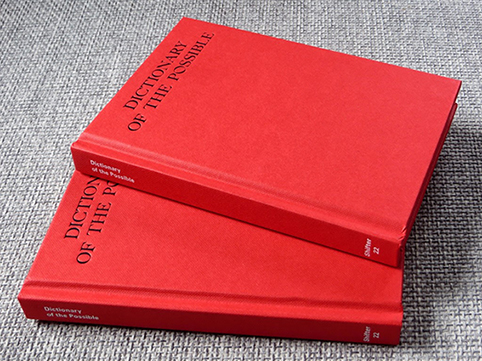
![]() Shifter
Shifter
Over the course of a year and a half Avi Alpert and Rit Premnath hosted a series of public discussions at The New School. Each meeting concentrated on unraveling a keyword – a term that carries with it both a sense of urgency and agency in our present climate. By inviting artists, writers, activists, philosophers and others to propose terms and lead discussions, they opened up their editorial process to the motivations of an interdisciplinary group.
This yearlong series has culminated in Shifter’s 22nd issue Dictionary of the Possible. This "dictionary" catalogs the keywords taken up for discussion over the course of a year, accompanied by a list of questions provoked during each discussion. Rather than providing static definitions they present a book that continually incites discussion.
Contributors:
Abhishek Hazra, Adam Spanos, Alison O’Daniel, Allan deSouza, Amanda Parmer, Andrea Geyer, Andrew Weiner, Annika Thiem, Arlen Austin, Atul Bhalla, Avi Alpert, Billy Galperin, Brendan Fernandes, Brian Block, Cassandra Guan, Chelsea Knight, Chitra Ganesh, Colin Jager, Colleen Macklin, Danilo Correale, Devin Kenny, Dominic Pettman, Dwayne Dixon, Francesca Coppola, Edward Schexnayder, Eric Angles, Gabriel Rockhill, Géraldine Gourbe, Henry Turner, Hong-An Truong, Jane Jin Kaisen, Jaret Vadera, Kajsa Dahlberg, Kanishka Raja, Keith Tilford, Lana Lin, Lauren Denitzio, Leah DeVun, Lindsay Benedict, Liz Park, Margarita Sánchez, Mari Cruz Alarcón, Matthew Metzger, Mériam Korichi, Mimi Winick, Mira Schor, Molly Dilworth, Mylo Mendez, Naeem Mohaiemen, Nick Keys, Oliver Kellhammer, Philipp Kleinmichel, Pushpamala N, Railbird, Raphael Zollinger, Raqs Media Collective, Rebecca Alpert, Research Service, Rey Chow, Rit Premnath, Roger White, Shadi Harouni, Siddhartha Lokanandi, Steffani Jemison, Sudha Premnath, Tara Kelton, Terike Haapoja, Thom Donovan, Tyler Coburn, Veronika Zink, Will Lee, Yamini Nayar, Zac Gunter
Editors:
Sreshta Rit Premnath, Avi Alpert
Designer:
Gabriel Pericàs
New York Art Book Fair
September 16-18, 2016
Preview September 15
MoMA PS1
22-25 Jackson Ave
Queens, NY 11101
2016-06-23
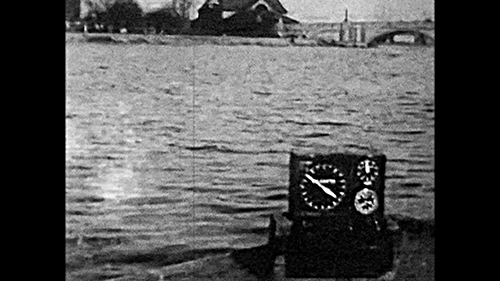
![]()
Working Conditions
Carole Condé and Karl Beveridge, Kajsa Dahlberg,
Duane Linklater → John Hampton, Juan Ortiz-Apuy, Joshua Schwebel
Curated by Sam Cotter
June 23 – August 6, 2016
Working Conditions brings together the work of artists questioning where they stand and what they stand amidst. Acknowledging that the studio exists at the intersection of many ecologies, the artists place themselves in relation to factors beyond their place of production, looking at the power dynamics, blind spots and measures of success contained in the economies and ecosystems surrounding them. Their interactions negotiate complicities, rights and responsibilities while pushing at the blurry boundaries between art and life.
In
Working Conditions, the act of asking a question is framed as a tool to confront reality: taking stock of both one’s position and the conditions around them. Here production is linked to conversation and negotiation, assembling becomes a means of disassembly and concrete answers dissolve into a search for better questions.
Within the exhibition, the term “working conditions” becomes twofold: signalling evaluation, as the artists look outward to understand the mechanics of work and labour framing their practice, and introspection, as the artists form their personal terms of engagement or the conditions under which they are willing to work. Looking at a diverse range of subjects—from the moderators of Wikipedia to the producers of video equipment, from the precarious economies of artist-run centres to the family breakfast table and beyond—the artists in
Working Conditions ask how their actions influence and are influenced by the world around them.
2016-06-07
A dialogue between Gabrielle Moser and Helena Reckitt in OnCurating that was just published:
Feminist Tactics of Citation, Annotation, and Translation: Curatorial Reflections on the Now You Can Go programme
2016-05-24 to 2016-06-24
No play
Feminist Training Camp at nGbK
21 May - 24 June 2016 // Opening: 20 May 2016
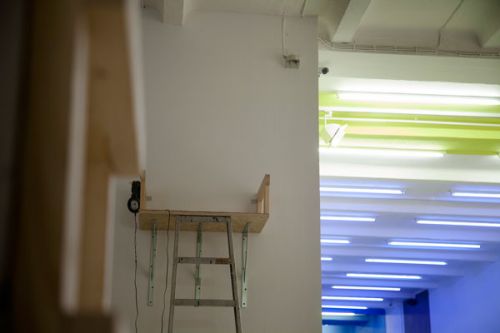
![]()
Wassan Ali, Bini Adamczak & Konstanze Schmitt, Anna Bromley, Cinenova Feminist Film and Video Distributor / Karolin Meunier & Sandra Schäfer, COOL FOR YOU, Kajsa Dahlberg, Athena Farrokhzad, Feministische Gesundheitsrecherchegruppe Berlin / Julia Bonn & Alice Münch & Inga Zimprich, Feminist Repair Café / Elisa Garrote Gasch, Annie Goh, Minna Henriksson, International Women's Space, Karolina Kucia, Las Hipókritas, Lowkick Tag Team, Peer Projekt / Hydra, Iris Rajanayagam, Noha Ramadan, reboot.fm / Diana McCarty, Naomi Rincón Gallardo, Sabrina Saase & Lanca, Nora Sternfeld, Dominika Trapp & Virág Bogyó, MC Xuparina, Andrea Zarza & Miranda Iossifidis a.o.
A message from the future is warning us that time is running out.
In the past years Europe’s colonial continuities and deeply rooted fascist practices have come to the fore in ever more frightening ways. Resistance is now crucial. We urgently need to revive old and develop new feminist and anti-fascist strategies of resistance and survival.
What training do we need?
No play proposes a structure, a temporal, spatial and social architecture that turns the exhibition space of nGbK into a resource, a site of activity and exchange in the shape of a Feminist Training Camp.
The Training Camp stems from a queer understanding of feminism with a strong emphasis on grassroots models of collective organization, knowledges based in lived experience and the handling of daily oppressions. A space for disagreement and negotiation that can create a situated public considered political. For this, an intersectional understanding of how categories such as gender, race, class, ability, and sexual orientation are intertwined in oppressive power structures is necessary.
2016-05-21 to 2016-06-23
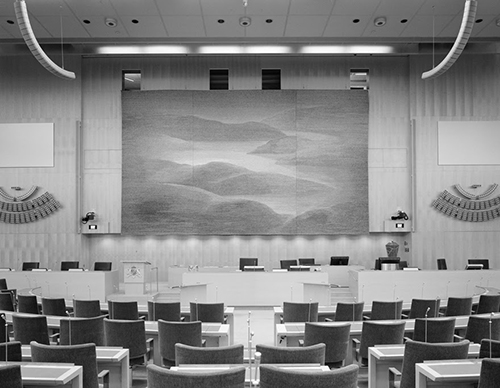
![]()
Memory of a Landscape
Curated by Henrik Andersson
May 21 – June 23, 2016
Sahar Al-khateeb, Henrik Andersson, Maher Abdul Aziz, Kajsa Dahlberg,
Jasmin Daryani, Silje Figenschou Thoresen, Hamish Fulton,
Elisabet Hasselberg Olsson, Saskia Holmkvist, Matts Leiderstam, Carl Erik Ström
About the exhibition
Rödbodtorget 2, Stockholm
2016-03-09
I will be screening a couple of my films as part of this fantastic project by Clara López Menéndez and Andrew Kachel
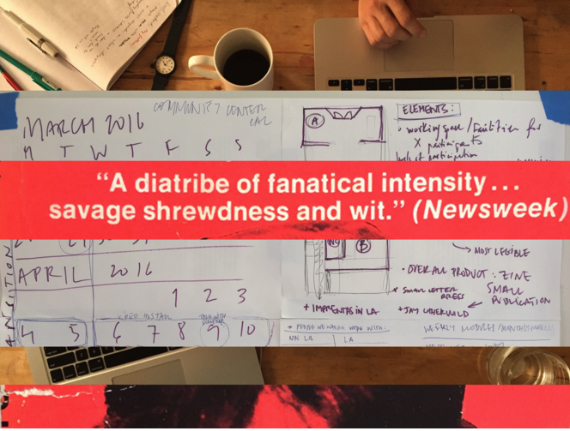
![]() A new job to unwork at
A new job to unwork at
Organized by Clara López Menéndez and Andrew Kachel in the LACE Project Room
Participants include Andrew Kachel and Clara López Menéndez (organizers), Rafa Esparza, Shoghig Halajian, Dylan Mira, Lee Relvas, Patrick Staff, and alexia welch.
Opening reception March 9, 2016 – 7:00-10:00pm
Exhibition dates: March 9, 2016 – April 17, 2016
Wednesday March 16, 6:30pm
Reach, Grasp, Move, Position, Apply Force – HD Video, 40 minutes, 16:9, Kajsa Dahlberg 2015
Wednesday March 23, 6:30pm
The All-Around Reduced Personality (Die Allseitig reduzierte Persönlichkeit – Redupers) – 35mm to Digital, 95 minutes, 4:3, Helke Sander, 1978
Wednesday April 6, 6:30pm
The Nightcleaners – 16mm to Digital, 90 minutes, 4:3, Berwick Street Film Collective, 1970-1972
more info at
anewjobtounworkat.tumblr.com/
2016-02-27 to 2016-03-06
I'm part of this great event in Oslo next week. Hope you can come!
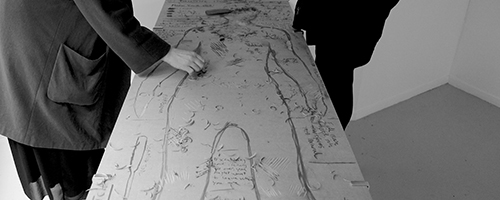
![]()
Extended Stipendiatforum
29 February - 6 March 2016
Atelier Felix and Akademirommet
Kunstnernes Hus, Oslo
Stipendiatforum is hosting a weeklong forum at Kunstnernes Hus from February 29th to March 6th, 2016. The forum is organised in sessions where participants are encouraged to alternate between practical formats and approaches to thinking practice.
With a focus on sharing of methods, techniques and pedagogies we are perhaps able to shift and/or sharpen our individual attention or collective awareness. If so, where and how do we find ourselves and our work in the intersections of formal, political and therapeutical art practices?
The forum meetings will take place in Atelier Felix, a new round table room in Kunstnernes Hus, and the screenings etc. will take place in Akademirommet in the same building. The program is open for the general public to engage in. Please note that certain parts might have limited places. First come, first serve. For details please contact livbugge@khio.no or jespalva@khio.no.
Stipendiatforum is a semi autonomous forum for the research fellows at the Oslo National Academy of the Arts (KHiO). Since 2013, the forum has invited different guests for a day or two in conversation in different homes, sidewalks and meeting rooms. The intention has been to share and engage in each other’s practices through conversation that develops with time, care and within an informal structure.
________
Participants:
Emily Roysdon, Malin Arnell, Melinda A. Meyer, Angela Melitopoulos, Marc Herbst, Anders Paulin, Arkadi Zaides, Liv Bugge, Jesper Alvær, Lisa Torell, Ingri Fiksdal, Ingvild Holm, Raphaël Grisey, Mike Sperlinger, Tale Næss, Susanne Winterling, Eddie Esmail, Tina Jonsbu, Jørn Mortensen, Janne-Camilla Lyster, Rike Frank, Finn Iunker, Merete Røstad, Venke Sortland, Pernille Holden, Kai Johnsen, Brynjar Bandlien, Gunhild Mathea Olaussen, Anders Paulin, Ane Hjort Guttu, Kajsa Dahlberg, Bull.Miletic, Paula Cobo-Guevara, Edvine Larssen, Silje Marie Aker Johnsen, Mai Hofstad Gunnes
2015 - 12 - 15
///////////
Heroic Exhaustion
Gallery Nova, Teslina 7, Zagreb
15/12/2015 -30/1/2016
Maja Čule, Kajsa Dahlberg, Katerina Duda, Mihael Giba, Hrvoje Hiršl
Curatorial concept: Martina Kontošić
The phenomenon of suffocation of public space by intensely communicated content defines contemporary society, together with the ways in which the very society treats this phenomenon. The precarization of the system is in full force; even those more successful, if they are attempting to preserve full moral integrity, enter exceedingly disadvantageous relations of invested labour, free time and financial compensation.
Heroic exhaustion is partly an auto-ironic construct of the protagonist of artistic scene which refers not only to the physical and mental exhaustion of those included, but also to the exhaustion of ways and spaces which are used for greater visibility of artistic activity. An intensive struggle for public space is being fought, both for physical spaces or locations of still existing cultural magazines and papers, as well as for the space for transferring messages and competing for the attention of the audience whose concentration is growing weaker. By analysing approaches to communicating the desired message, the exhibition presents artistic positions of different critical intensities directed towards the system they are a part of. The key element is the control over personal freedom of agency which is endangered by the general precarization of employment. By exhibiting various methods of artistic work, we are influencing not only the interpretation of the notion of heroic exhaustion which becomes not only ironic, but also an accommodating description of current state of a generation imprisoned within inevitable changes of social and economic relations.
The exhibition is a part of the collaborative project This Is Tomorrow. Back to Basics: Forms and Actions in the Future of What, How & for Whom/WHW, Zagreb, Tensta Konsthall, Stockholm and Latvian Center for Contemporary Art / LCCA, Riga, with the support of the Creative Europe Programme of the European Union.
2015 - 12 - 13
Laura Guy and I are doing the workshop as part of the
NOW YOU CAN GO seminar:
# Intimate Acts: A feminist workshop
Sun 13 Dec, 10.00am-13.00pm
The Showroom, 63 Penfold Street, NW8 8PQ London, United Kingdom
A half-day workshop exploring collective acts of annotation, translation, and recontextualisation in relation to feminist reading and writing.
“Intimate Acts” is an attempt to produce a collective political language through a series of practical activities organised around extracts of existing text. The workshop will consider how strategies of citation, translation, annotation and appropriation can be put into the service of a feminist politics and what is at stake in doing so.
Reading transforms the meaning of a text. Sometimes this transformation manifests as a material intervention. For example, annotations generate an alternative text in the margins of an original. Underlining passages, we single out extracts to return to at a later point, share with others, or else deploy in a different context. Quotations articulate things that matter at the time. They help to give form to our own feelings, desires and demands. Reading allows us access to languages other than our own and in turn gives written language over to circulate as a new set of possibilities.
Feminism has often emphasised experimental forms of literature. It has politicised reading through collective reading groups and by developing radical approaches to translation and distribution. Feminist writers have worked to show how language shapes us and have invented strategies in order to reconfigure, disrupt or undermine what Gertrude Stein once referred to as “patriarchal poetry”. In doing so, feminist literature and theory has made traditional forms of language speak otherwise in the on-going pursuit for self-knowledge and self-determination.
Participants are asked to bring a book with them in which they have underlined a short passage of text.
Booking available through
Eventbrite
2015 - 12 - 01 to
2015 - 12 - 13
NOW YOU CAN GO
A programme of events considering feminist thinking, art and activism, taking place across
The Showroom , the
ICA ,
Space Studios and
Raven Row , (1–13 December, London 2015).
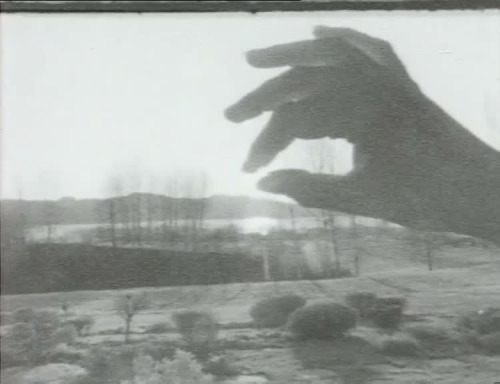
![]() Image: Anna Valeria Borsari, Autoritratto in una stanza, documentario [Self-Portrait in a Room, Documentary], 1977, still from video. Courtesy of the artist and Archivio Cavallino, Venice.
Image: Anna Valeria Borsari, Autoritratto in una stanza, documentario [Self-Portrait in a Room, Documentary], 1977, still from video. Courtesy of the artist and Archivio Cavallino, Venice.
More info about that and the whole seminar here:
http://nowyoucango.tumblr.com/
Download full programme
Juxtaposing historical with contemporary positions, the series explores feminist concepts of generation and genealogy. It asks whether practices of consciousness-raising and collectivity might help us to combat the fragmentation, exhaustion and anxiety that we experience under networked capitalism. The programme draws inspiration from Italian feminisms, including the work of collectives formed in the 1970s: Rivolta Femminile (Female Revolt), Libreria delle Donne di Milano (Milan Women’s Bookstore Collective), and Lotta Femminista (Feminist Struggle).
A touchstone is the work of Carla Lonzi, the writer and cofounder of Rivolta Femminile, and her refusal of power and rejection of masculine creativity that exploits female supportive activity. This process of ‘deculturation’ entailed Lonzi’s withdrawal from her roles as an art critic, as a feminist leader, and from her relationship with her lover, the sculptor Pietro Consagra, which she documented in a dialogue between them called Vai pure (Now You Can Go).
Now You Can Go grows out of the Feminist Duration Reading Group which meets monthly at Space Studios in London. The programme has been developed by participants from the Feminist Duration Reading Group including Angelica Bollettenari, Giulia Casalini, Diana Georgiou, Laura Guy, Irene Revell and Amy Tobin, and is coordinated by Helena Reckitt with Dimitra Gkitsa.
Supported by the Arts Council of England, Grants for the Arts.
With additional support by Goldsmiths’ Annual Fund, Goldsmiths’ Art Department, and the Women’s Art Library at Goldsmiths, University of London; EWVA European Women’s Video Art in the 70s and 80s’ (DJCAD, University of Dundee); IASPIS; and Electra.
2015 - 11 - 14
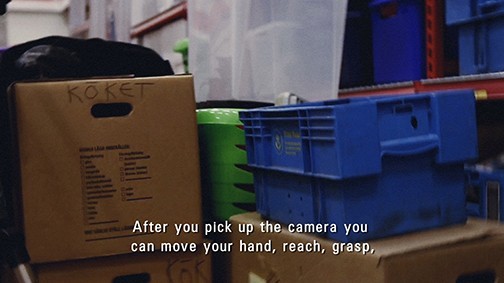
![]()
Finissage/Screening:
From Here To Afternoon/
Reach, Grasp, Move, Position, Apply Force
As part of the finissage of Mikhail Lylov and Patrik Haggren's show
From Here to Afternoon there will be a screening of
Reach, Grasp, Move, Position, Apply Force at
D21 Kunstraum Kunstraum in Leipzig.
Reach, Grasp, Move, Position, Apply Force follows the development of film and video technology through time management systems, an invention that historically served to increase the efficiency of labor as well as to establish pathologies of neurophysiology. This recent work of Kajsa Dahlberg seeks to understand the way that these motions, measured in time, today are a source of conflict in conglomerate companies like Amazon and Apple, but also in freelance work, and questions their utility for strategies of both control and resistance. The film may also be considered a reflection on the conditions of artistic practice.
Screening and discussion at 16:00
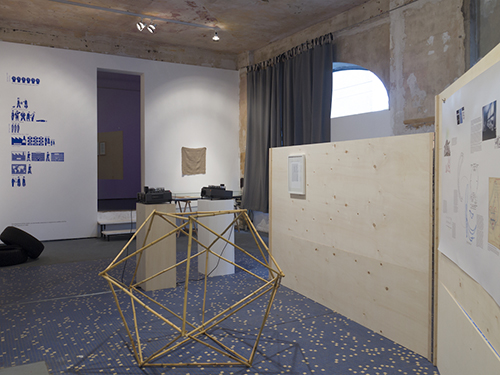
![]()
From Here to Afternoon borrows its initial gestures from an early 20th century photographic technology for motion study applied by North American labor engineers and adapted by Soviet neurophysiology. In the works of the exhibition's artists, techniques for externally taking control over movements of individual and collective bodies come across their counter-techniques, as when processes toward movement's formalization in the organization of work, are utilized in the organization against subjection. These tactical relations between capital and labor, state and individual always leave readable or reconstructible traces, that the exhibition attempts to demonstrate as possible ways of looking for counter strategies behind the images of past resistances.
With works by: Elke Marhöfer, Romana Schmalisch, Liz Magic Lazer, Alice Creischer and Andreas Siekmannn, Arseniy Zhilyaev.
2015 - 11 - 06
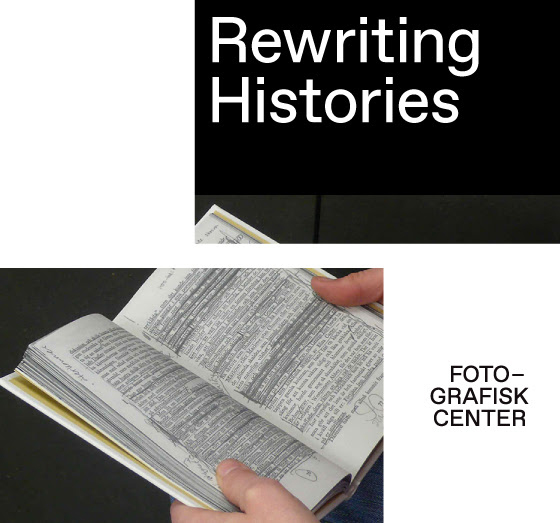
![]()
Rewriting Histories
06.11 – 20.12.2015
Akram Zaatari, Andrea Geyer, Benj Gerdes & Jennifer Hayashida, Benjamin Tiven, Inuk Silis Høegh, Katya Sander, Kajsa Dahlberg, Lasse Lau, Lin + Lam, Matthew Buckingham, Michelle Dizon, Naeem Mohaiemen, Nanna Debois Buhl, Pia Arke & Anders Jørgensen, Raed Yassin, Rania Rafei & Raed Rafei, Regina José Galindo, Robert Ochshorn, Sergio De La Torre, Stéphane Gérard, Sarah Vanagt & Katrien Vermeire, William E Jones
Thursday, November 5th at 5pm – 7pm
The exhibition will be opened by visual artists and curators Lasse Lau &
Benj Gerdes
Rewriting Histories examines how history can be retold from a contemporary perspective through film and video works, slide installations and photography by internationally renowned Danish as well as international artists. The exhibition focuses on history and the archive - a theme in art - that with recent political events has received renewed attention and relevance. Rewriting Histories – conceptually staged in an intriguing visual language - is curated in collaboration with artists Lasse Lau and Benj Gerdes at Photographic Center.
2015 - 11 - 06
A Feminist Culture Reader
- et udstillingsprojekt af Peter Brandt
Fernisering, Danske Grafikeres Hus fredag d.6 november kl.17-20
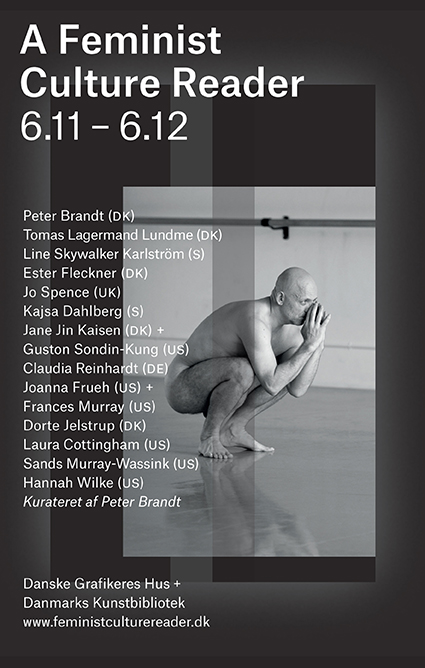
![]() A Feminist Culture Reader undersøger den enorme indflydelse feministisk tænkning har, og har haft, på forskellige generationer af billedkunstnere, i et nationalt og internationalt perspektiv.
A Feminist Culture Reader byder på værker af kunstnere med vidt forskellige (feministiske) positioner, der hver især giver et indblik i eksistens set igennem køn, traume og (kunst)historisk materiale.
A feminist Culture Reader består af en solo udstilling af Peter Brandt, samt en gruppeudstilling i Danske Grafikeres Hus. I forbindelse med de to udstillinger vises en række satellit udstillinger rundt omkring i byen, der skaber en dialog om udstillingernes tematikker på tværs af institutioner.
Mer info: www.feministculturereader.dk
A Feminist Culture Reader undersøger den enorme indflydelse feministisk tænkning har, og har haft, på forskellige generationer af billedkunstnere, i et nationalt og internationalt perspektiv.
A Feminist Culture Reader byder på værker af kunstnere med vidt forskellige (feministiske) positioner, der hver især giver et indblik i eksistens set igennem køn, traume og (kunst)historisk materiale.
A feminist Culture Reader består af en solo udstilling af Peter Brandt, samt en gruppeudstilling i Danske Grafikeres Hus. I forbindelse med de to udstillinger vises en række satellit udstillinger rundt omkring i byen, der skaber en dialog om udstillingernes tematikker på tværs af institutioner.
Mer info: www.feministculturereader.dk
2015 - 11 - 04
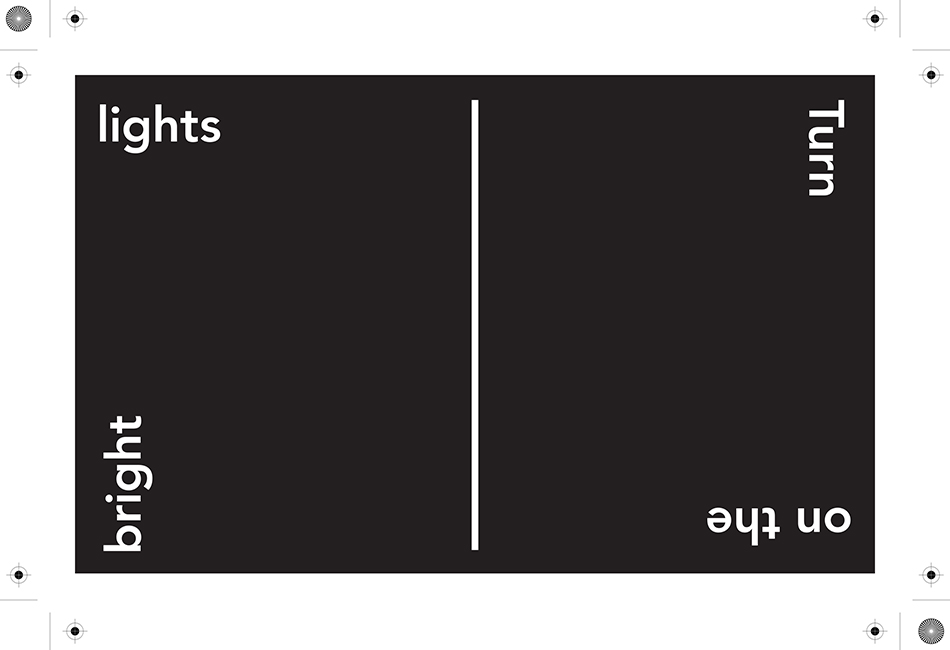
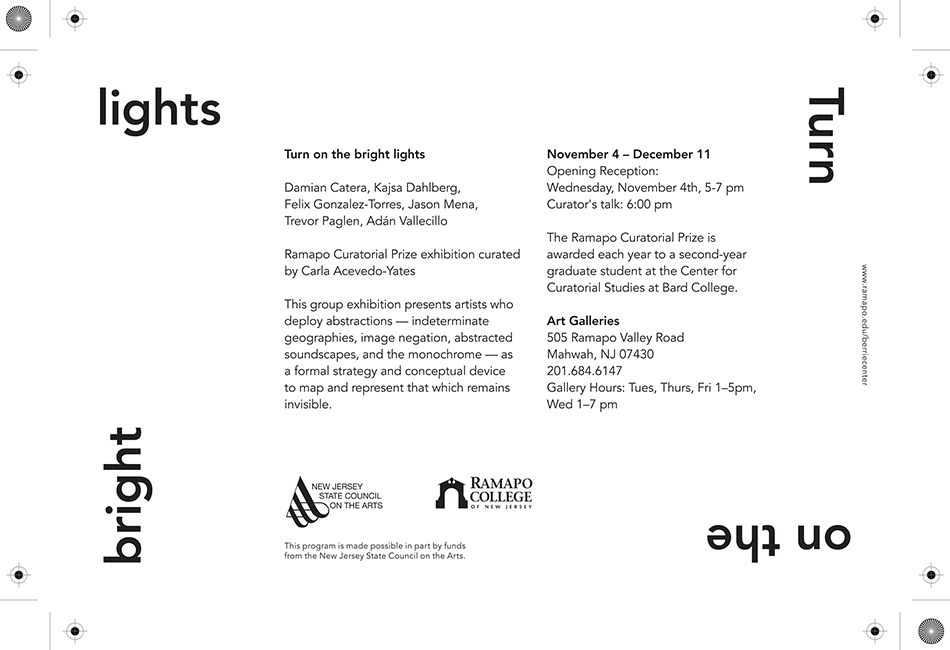
![]()
2015 - 10 - 20
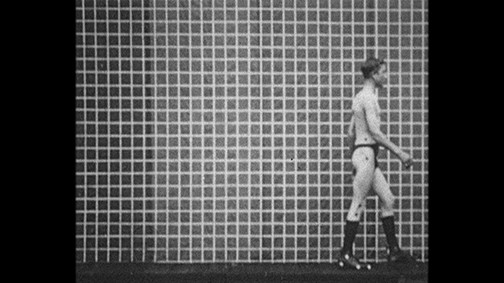
![]()
Jakten på tid i arbetets rörelser - Kajsa Dahlberg
Tisdag 20 oktober 2015, kl 18.00
BAR10, Konstepidemin, Konstepidemins väg 6
I serien Arbetarkonst: System som ”Methods –Time Measurement” (MTM) markerade på slutet av 1940-talet ett radikalt brott i synen på kroppsarbete genom att fokusera på mänskliga rörelser. I filmen Reach, Grasp, Move, Position, Apply Force undersöker Kajsa Dahlberg genom videotekniken hur dessa rörelser knutna till tid idag förhandlas inom alltifrån gigantiska företag som Amazon och Apple till budfirmor och frilansare. Filmtiteln beskriver samtidigt Dahlbergs konstnärliga metod för arbetstidsundersökning.
I samarbete med BAR10 och tidskriften Paletten
Tisdag 20 oktober 2015, kl 18.00, BRA10, Konstepedimin, Göteborg
2015 - 09 - 14
Interview with:
artistoftheweek.dk #57
2015 - 09 - 4 - 2015 - 09 - 6
MABL ISTANBUL
September 4-6, 2015
MABL -Mobile Artist's Book Libraryvisits Istanbul to present and collaborate with Swedish and Turkish artists' books and related artists. The aim is to exchange thoughts, ideas, artistic methods and works and not theleast to initiate possible future collaborations with artists and organisations on location. As a follow up and continuation of the project and the exchange in Istanbul MABL is invited to Plattan Library at Kulturhuset in Stockholm later this fall 2015.
In conjunction with the opening of the Istanbul Art Biennal MABL runs a three dayprogrammed presentation at Aciliyet Mektebi/School of Urgency and the bookstore Robinson Crusoe 389 at SALT Beyoğlu. Also includingan event at BAS in Karakoy. MABL presents parts of its collection of artist's books and publications juxtaposed with parts of BAS collection. BAS is an artist run space in Istanbul initiated by Banu Cennetoğlu where artists' books and publications arecollected, displayed and produced.
The program includes specially invited artists from Sweden and Turkey presenting works in the shape of books, sound, objects, performance, as well as talks and walks.
Participating artists and organisations in Istanbul:
Merve Ertufan
Elmas Deniz
Meriç Algun Ringborg
BAS
Banu Cennetoglu
Nihan Somay
Açiliyet Mektebi
Beata Berggren
Helena Eriksson
Kajsa Dahlberg
Ulla West
Tina Eriksson Fredriksson
www.mabl.se
2015 - 07 - 13
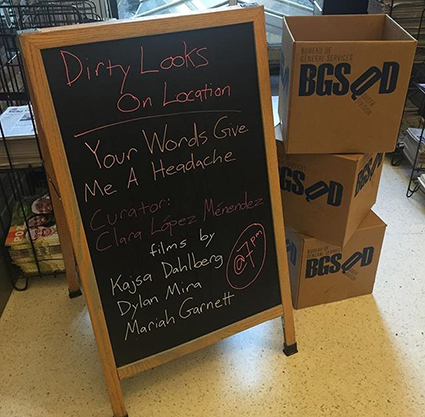
![]()
Your Words Give Me a Headache
July 13 at 7 pm
Curated by Clara Lopez
2015 - 06 - 04

![]()
CAC Bukovje Landskrona present:
Two exhibitions for the Kilometre of Sculpture, Võru, Estonia: "Working Drawings And Other Visible Things On Paper Not Necessarily Meant To Be Viewed As Art (After Bochner)" and "Small Good Things (Artworks We Like That Fitted In Our Suitcases)"
Artists: Bengt Adlers, Conny Blom, Mel Bochner, Kalle Brolin, Vasja Cenčič, Martin Creed, Kajsa Dahlberg, Jeremy Deller, Ditte Ejlerskov, Milanka Fabjančič, Vadim Fishkin, Tomaž Furlan, Johan Furåker, Alexander Gutke, Felix Gmelin, Carl Michael von Hausswolff, Ištvan Išt Huzjan, IRWIN, Janez Janša, Janez Janša and Janez Janša, Stine Marie Jacobsen, Lisa Jeannin, Žiga Kariž, Clay Ketter, Jukka Korkeila, Anna Ling, Anna Lundh, Miltos Manetas, Jonathan Meese, Peter Miller, Kristina Müntzing, Jesper Norda, Björn Perborg, Magnus Petersson, Adrian Piper, Klara Sax, Lina Selander, Emelie Sjunnesson, Nataša Skušek, Nina Slejko Blom, Nedko Solakov, Mladen Stropnik, Annika Ström, Stefanos Tsivopoulos, Leon Zuodar, Serkan Özkaya, Ulla West, Johan Wik.
2015 - 05 - 29
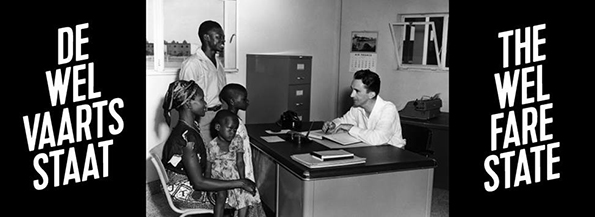
![]()
THE WELFARE STATE
29.05 – 27.09.2015
The Welfare State contains new and existing works by eight artists of different generations: Francisco Camacho Herrera, Josef Dabernig, Kajsa Dahlberg, Róza El-Hassan, Donna Kukama, Artūras Raila, Anne-Mie Van Kerckhoven and Stephen Willats. It also contains visual and textual material from the four cultural archives in Flanders: Amsab and the Liberal Archive in Ghent, KADOC in Leuven and ADVN in Antwerp.
Curator: Anders Kreuger
The welfare state is an abstract notion. But also very concrete. Political, but also bureaucratic. What does it have to do with art?
The welfare state operates with regulations, rights and obligations that apply to everyone in the same way, requiring individuals to identify themselves as members of society first and foremost. In this sense, the welfare state is the antithesis of art. Many artists support the welfare state in both theory and practice, and they are fascinated by rules as such, but they have little interest in following rules formulated by others than themselves…
The welfare state is an emancipatory political project, although it was first invented as a way of keeping class struggle and revolution at bay. It is hard to disassociate the European welfare state from the darker elements of recent history, such as militarism, colonialism and the degradation of the natural environment. Yet the welfare state, as a model for social cohesion and political stability, is now gaining ground in new parts of the world, notably in East Asia.
The exhibition
The Welfare State does not look back with nostalgia at the welfare state in its ‘classical’ form as a utopian blueprint for an egalitarian (and homogenous) society in postwar Western Europe. It does not invite artists to ‘illustrate’ political and social engagement. But it does ask some fundamental questions. What is the ‘imaginary’ of the welfare state? Does it have a ‘form’? Can it be ‘shown’?
The Welfare State is accompanied by a printed publication, and by an ambitious discursive programme. During the spring of 2015
M HKA organises a series of public seminars in collaboration with the researchers at the Herman Deleeck Centre for Social Policy at the University of Antwerp. Public forums are organised on 30 May 2015 at Cinema Zuid in Antwerp, in collaboration with CAHF (Contemporary Art heritage Flanders) and in September in Brussels, in collaboration with the Flemish-Dutch House deBuren.
2015 - 05 - 18
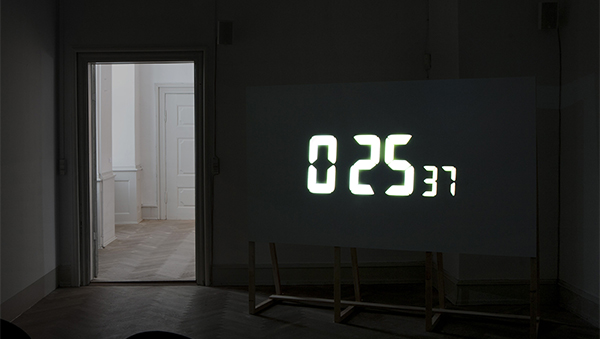
![]() We Can (Not) Work It Out: A Curatorial Inquiry into the Danish Radio Archive
We Can (Not) Work It Out: A Curatorial Inquiry into the Danish Radio Archive is a practice-based PhD thesis written by
Trine Friis Sørensen, a curator and a PhD candidate at Department of Arts and Cultural Studies, University of Copenhagen.
The thesis is based on the commission of two artists, Kajsa Dahlberg and Olof Olsson, to produce artworks in relation to the DR Archive, the thesis inquires into the archival questioning that the artworks produce, and furthermore proposes a way to conduct research through curating.
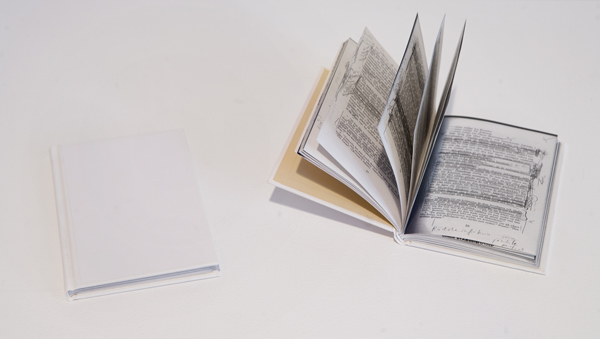
![]()
Judith Shakespeare – Undead or Alive? On Kajsa Dahlberg’s Artist Book
A Room of One’s Own / A Thousand Libraries in the publication
Notes On Location
2015 - 05 - 06
Friends and friends of friends join!
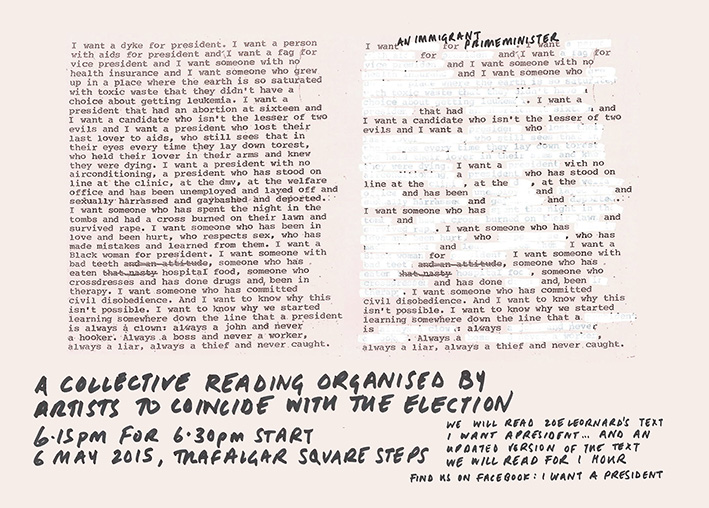
![]()
Facebook
This is part of a series of readings that have been organised internationally and which were first initiated by a group of artists, Malin Arnell, Kajsa Dahlberg, Johanna Gustavsson and Fia-Stina Sandlund, in dialogue with Zoe Leonard and in response to the 2010 election in Sweden. The readings are politically independent. More information on the project can be found
here and
here and
here.
2015 - 04 - 09
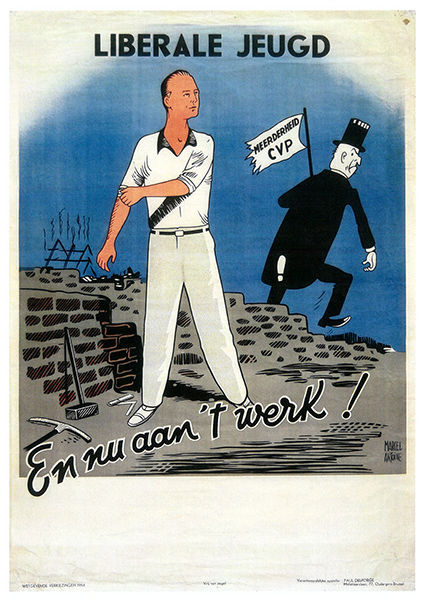
![]() 2015 - 03 - 16
2015 - 03 - 16
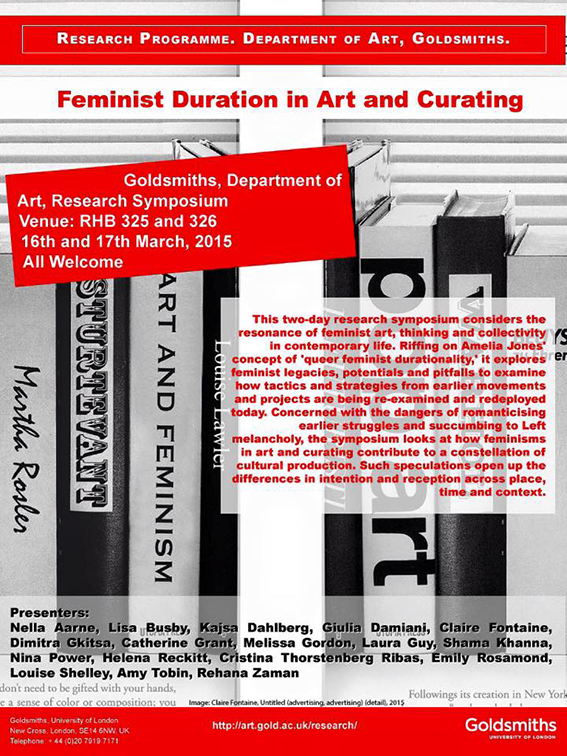
![]() Feminist Duration in Art and Curating
Goldsmiths, Department of Art, Research Symposium
16th and 17th March, 2015
This two-day research symposium considers the resonance of feminist art, thinking and collectivity in contemporary life. Riffing on Amelia Jones' concept of 'queer feminist durationality,' it explores feminist legacies, potentials and pitfalls to examine how tactics and strategies from earlier movements and projects are being re-examined and redeployed today. Concerned with the dangers of romanticising earlier struggles and succumbing to Left melancholy, the symposium looks at how feminisms in art and curating contribute to a constellation of cultural production. Such speculations open up the differences in intention and reception across place, time and context.
With:
Kajsa Dahlberg (Berlin and Malmö), Claire Fontaine (Paris), Laura Guy (Goldsmiths), Rehana Zaman (Goldsmiths), Helena Reckitt (Goldsmiths), Louise Shelley (The Showroom, London), art historian Catherine Grant (Goldsmiths), Nina Power (University of Roehampton).
At Goldsmiths College, Richard Hoggart Building, rooms 325-326,
New Cross, London
SE14 6NW
2015 - 01 - 19
Feminist Duration in Art and Curating
Goldsmiths, Department of Art, Research Symposium
16th and 17th March, 2015
This two-day research symposium considers the resonance of feminist art, thinking and collectivity in contemporary life. Riffing on Amelia Jones' concept of 'queer feminist durationality,' it explores feminist legacies, potentials and pitfalls to examine how tactics and strategies from earlier movements and projects are being re-examined and redeployed today. Concerned with the dangers of romanticising earlier struggles and succumbing to Left melancholy, the symposium looks at how feminisms in art and curating contribute to a constellation of cultural production. Such speculations open up the differences in intention and reception across place, time and context.
With:
Kajsa Dahlberg (Berlin and Malmö), Claire Fontaine (Paris), Laura Guy (Goldsmiths), Rehana Zaman (Goldsmiths), Helena Reckitt (Goldsmiths), Louise Shelley (The Showroom, London), art historian Catherine Grant (Goldsmiths), Nina Power (University of Roehampton).
At Goldsmiths College, Richard Hoggart Building, rooms 325-326,
New Cross, London
SE14 6NW
2015 - 01 - 19
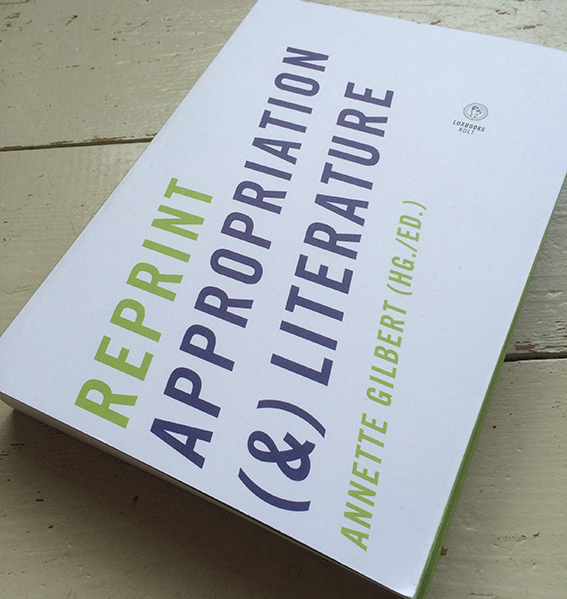
![]() REPRINT appropriation (&) literature
Annette Gilbert, a scholar in comparative literature at the Freie Universitaet Berlin, have written this fantastic book on appropriation litterature in which my piece A Room of One's Own / A Thousand Libraries is one of the examples.
Since the 1960s, writers have radically challenged the notion of originality and creativity in literature. They stopped writing new texts for their books and instead drew upon pre-existing books: canonical texts of world literature or intellectual history are transcribed by hand, edited, altered, alphabetically arranged or simply copied and republished under one’s own name. By now Appropriation Literature amounts to a critical mass that has generated its own tradition. The present anthology is the first to give an international overview of the phenomenon, presenting 126 books and projects by over 90 authors.
2014 - 10 - 18
REPRINT appropriation (&) literature
Annette Gilbert, a scholar in comparative literature at the Freie Universitaet Berlin, have written this fantastic book on appropriation litterature in which my piece A Room of One's Own / A Thousand Libraries is one of the examples.
Since the 1960s, writers have radically challenged the notion of originality and creativity in literature. They stopped writing new texts for their books and instead drew upon pre-existing books: canonical texts of world literature or intellectual history are transcribed by hand, edited, altered, alphabetically arranged or simply copied and republished under one’s own name. By now Appropriation Literature amounts to a critical mass that has generated its own tradition. The present anthology is the first to give an international overview of the phenomenon, presenting 126 books and projects by over 90 authors.
2014 - 10 - 18
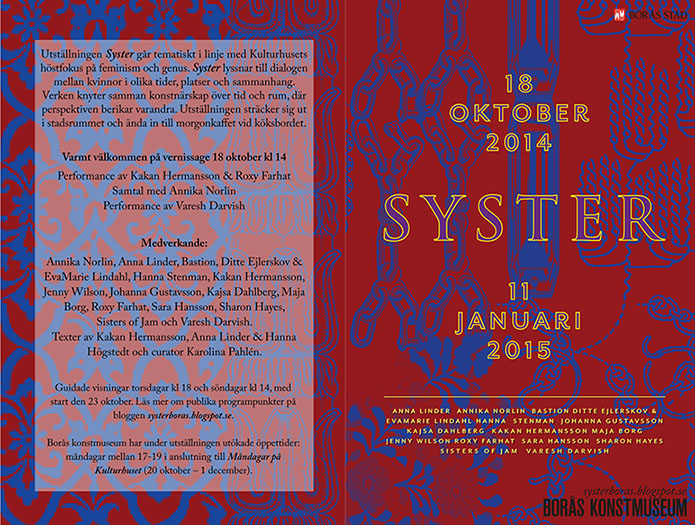 2014 - 09 - 17
2014 - 09 - 17
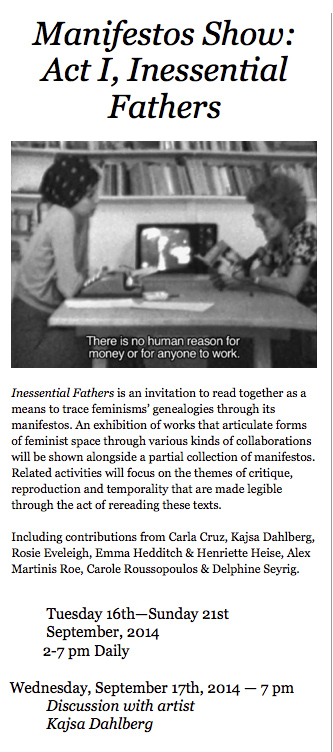
![]() 2014 - 07 - 14 - 2014 - 07 - 20
2014 - 07 - 14 - 2014 - 07 - 20
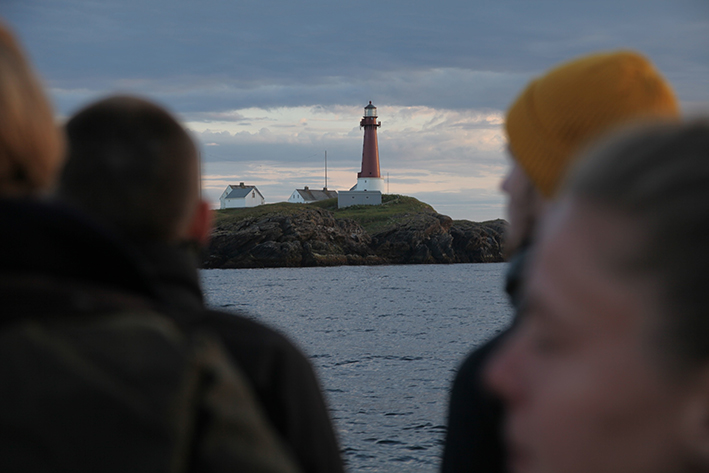
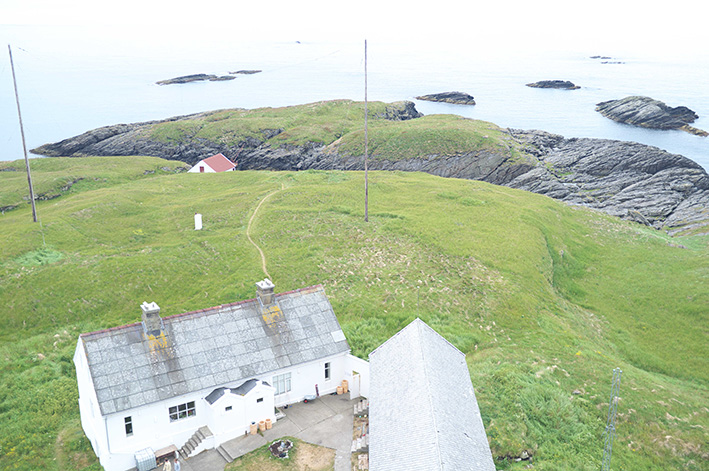 A week-long salon with 11 artists, curators and theorists at Skomvær Lighthouse organised by FRANK.
The salon was held at Skomvær Fyr in the Lofoten islands in Northern Norway, where Katarina Bonnevier, Liv Bugge, Malene Dam, Mathias Danbolt, Vika Begalska, Berivan Erdogan, Ester Fleckner, Jason Rosenberg, Sille Storihle, Elin Vister, Elijah Yakovenko and myself spent an amazing week together, sharing work and research. More at: f-r-a-n-k
2014 - 06 - 16
A week-long salon with 11 artists, curators and theorists at Skomvær Lighthouse organised by FRANK.
The salon was held at Skomvær Fyr in the Lofoten islands in Northern Norway, where Katarina Bonnevier, Liv Bugge, Malene Dam, Mathias Danbolt, Vika Begalska, Berivan Erdogan, Ester Fleckner, Jason Rosenberg, Sille Storihle, Elin Vister, Elijah Yakovenko and myself spent an amazing week together, sharing work and research. More at: f-r-a-n-k
2014 - 06 - 16
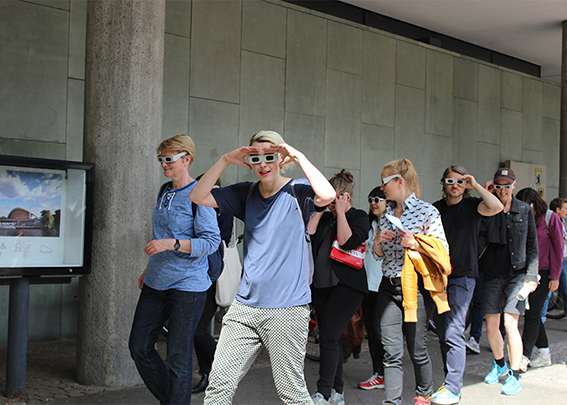 A a night walk during daytime through Tiergarten in Berlin on June 16 2014.
2014 - 04 - 10 - 2014 - 04 - 14
A a night walk during daytime through Tiergarten in Berlin on June 16 2014.
2014 - 04 - 10 - 2014 - 04 - 14
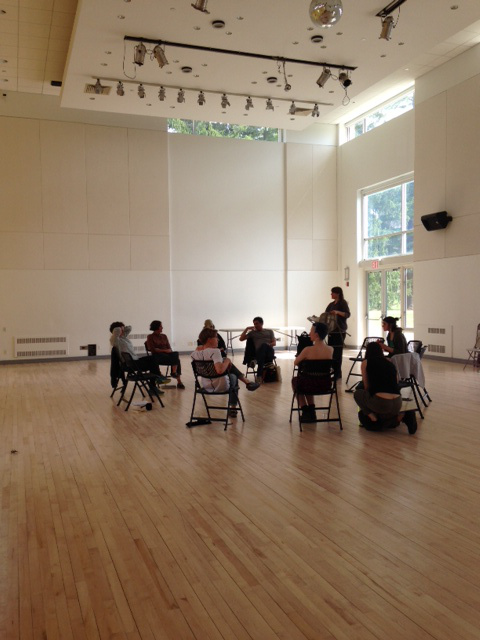 Is It Really working? A Physical Symposium/Crash Course has recently taken place within the framework of my MA thesis project for the Master in Curatorial Studies at CCS Bard.
The symposium/crash course occurred between April 10th and 14th 2014 and comprised a series of closed and open conversations and workshops among artists and culture agents coming from different fields of artistic production. The idea was to gather around a discussion concerning the current conditions of culture production, with the current situation for artists, curators, and other art workers in the area of NYC as a starting point. The lenses through which we departed in our conversations is a sense of commitment to political positions informed by feminist and queer politics, with the constant problematization and questioning that such political affiliations entail.
The core group that was invited to participate in this experimental platform was formed by Vanessa Anspaugh, Malin Arnell, Amelia Bande, Gregg Bordowitz, Kajsa Dahlberg, Andrew Kachel and Alhena Katsof. Arnell and Dahlberg, despite not being directly invited with the allocated budget for my project, were able to participate since they were also part of my classmates shows, Carla Acevedo-Yates and Andrew Kachel. Through a form of informal collaboration between us, they all were able to take part in these conversations, informing with their thoughtful formulations of their experience, the scope of the problematics brought to the table.
2014 - 02 - 28
Is It Really working? A Physical Symposium/Crash Course has recently taken place within the framework of my MA thesis project for the Master in Curatorial Studies at CCS Bard.
The symposium/crash course occurred between April 10th and 14th 2014 and comprised a series of closed and open conversations and workshops among artists and culture agents coming from different fields of artistic production. The idea was to gather around a discussion concerning the current conditions of culture production, with the current situation for artists, curators, and other art workers in the area of NYC as a starting point. The lenses through which we departed in our conversations is a sense of commitment to political positions informed by feminist and queer politics, with the constant problematization and questioning that such political affiliations entail.
The core group that was invited to participate in this experimental platform was formed by Vanessa Anspaugh, Malin Arnell, Amelia Bande, Gregg Bordowitz, Kajsa Dahlberg, Andrew Kachel and Alhena Katsof. Arnell and Dahlberg, despite not being directly invited with the allocated budget for my project, were able to participate since they were also part of my classmates shows, Carla Acevedo-Yates and Andrew Kachel. Through a form of informal collaboration between us, they all were able to take part in these conversations, informing with their thoughtful formulations of their experience, the scope of the problematics brought to the table.
2014 - 02 - 28
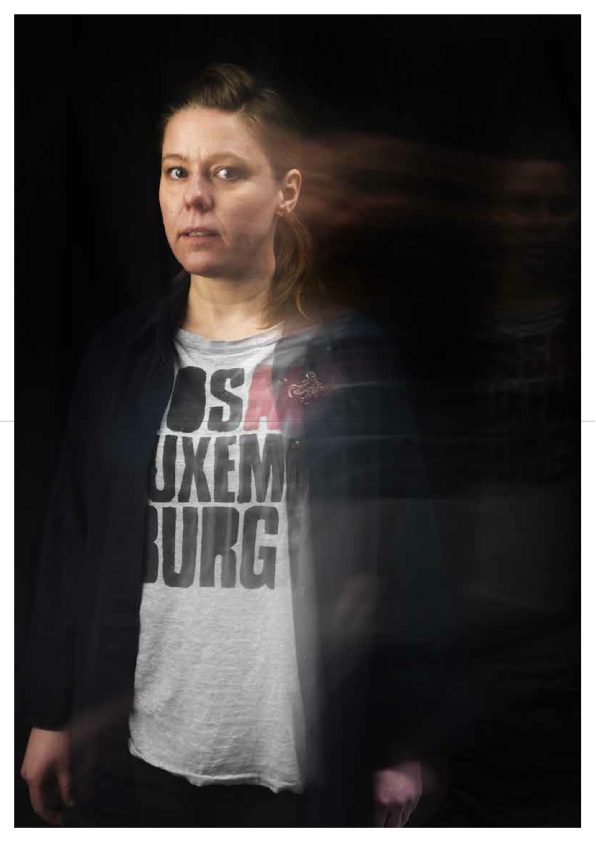
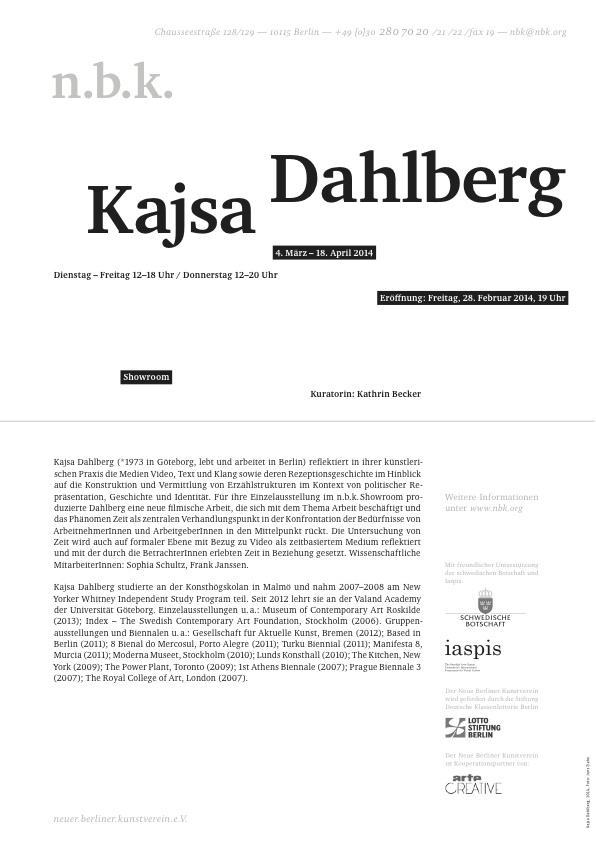

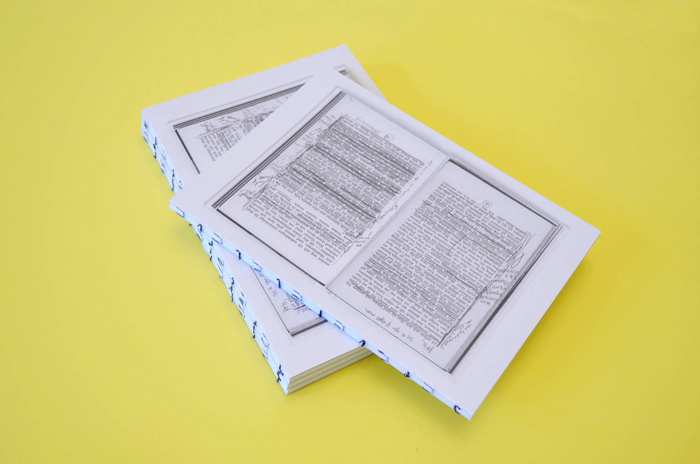 Voluspå
Voluspå marks the 100-year anniversary of the Norwegian suffrage movement. 2013 has been a year for celebrating women, feminism and equality, and through the book FRANK comments on the centennial and questions the established narration of feminist history. It serves as an exploration of this lineage in Norway and Sweden through the lives and works of artists and writers. The book features Vanessa Baird, Katarina Bonnevier, Kajsa Dahlberg, Mathias Danbolt, Marie Høeg, Hilma af Klint, Carl Larsson, Klara Lidén, Wencke Mühleisen, Claes Oldenburg, Henrik Olesen, Sidsel Paaske and Martin Skauen.
Voluspå
Voluspå marks the 100-year anniversary of the Norwegian suffrage movement. 2013 has been a year for celebrating women, feminism and equality, and through the book FRANK comments on the centennial and questions the established narration of feminist history. It serves as an exploration of this lineage in Norway and Sweden through the lives and works of artists and writers. The book features Vanessa Baird, Katarina Bonnevier, Kajsa Dahlberg, Mathias Danbolt, Marie Høeg, Hilma af Klint, Carl Larsson, Klara Lidén, Wencke Mühleisen, Claes Oldenburg, Henrik Olesen, Sidsel Paaske and Martin Skauen.

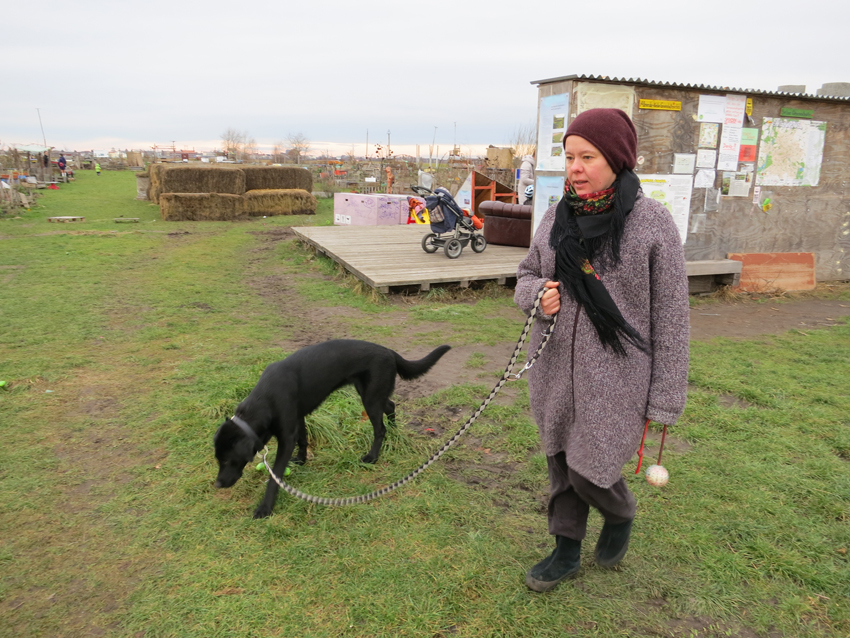 Cac-Conceptual Art Center Bukovje
Cac-Conceptual Art Center Bukovje

_HEM.jpg)
bild_HEM.jpg)

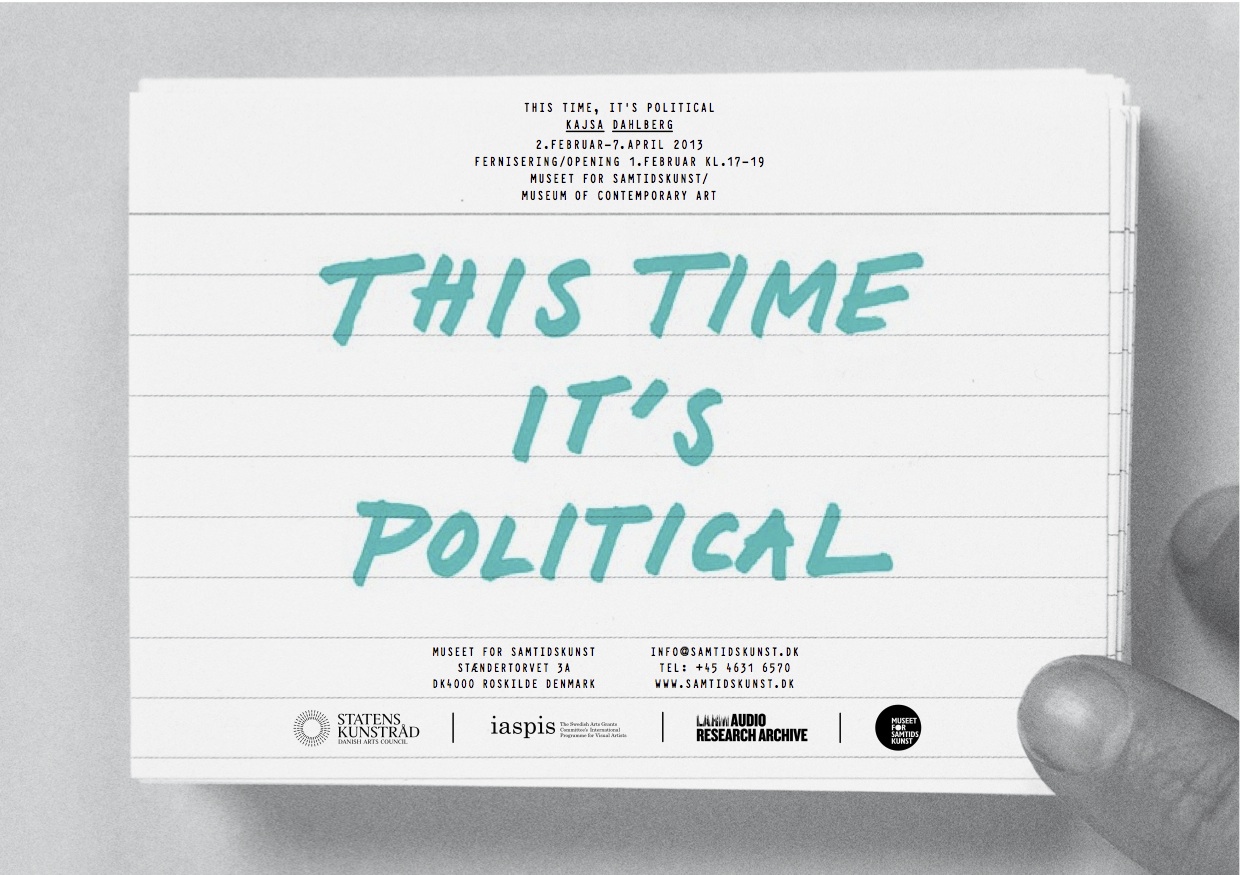

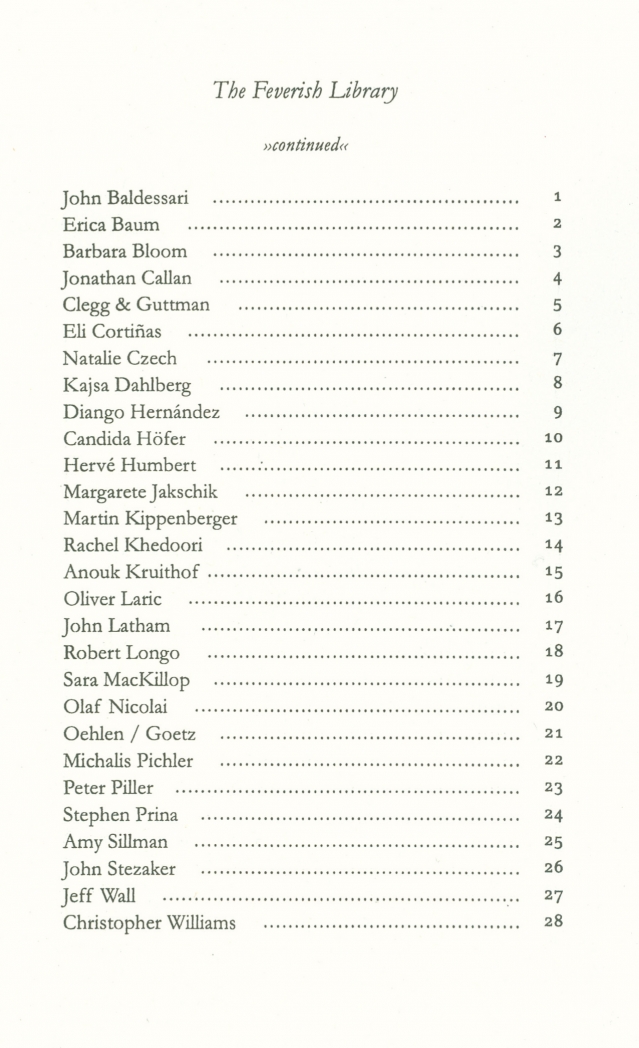 The Feverish Library (continued)
19 January – 23 February 2013
Opening Saturday 19 January, 6 – 8.30pm
Karl-Marx-Allee 45, 10178 Berlin, +49 30 2408 8130
info@capitainpetzel.de, www.capitainpetzel.de
The Feverish Library (continued)
19 January – 23 February 2013
Opening Saturday 19 January, 6 – 8.30pm
Karl-Marx-Allee 45, 10178 Berlin, +49 30 2408 8130
info@capitainpetzel.de, www.capitainpetzel.de

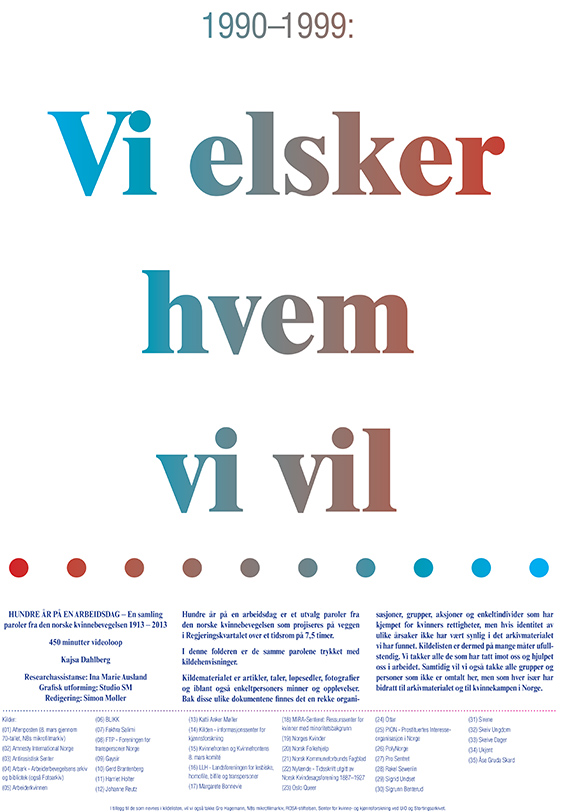 PDF Broschyr 100 år
Poster procuced as part of the public art comission at the Government building R6 in Oslo, Norway. The piece One hundred years in a workday is a 7,5 hour long videoloop installed at the entrance of the building. Inaugurated on December 3rd 2012.
PDF Broschyr 100 år
Poster procuced as part of the public art comission at the Government building R6 in Oslo, Norway. The piece One hundred years in a workday is a 7,5 hour long videoloop installed at the entrance of the building. Inaugurated on December 3rd 2012.

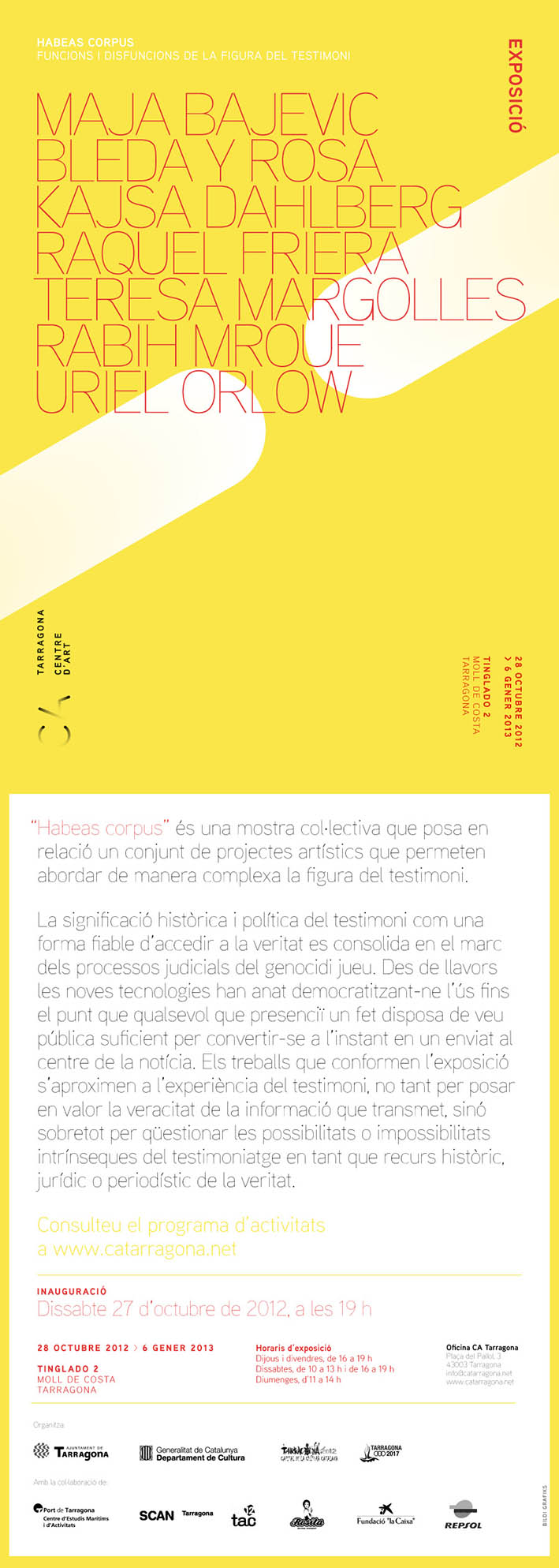

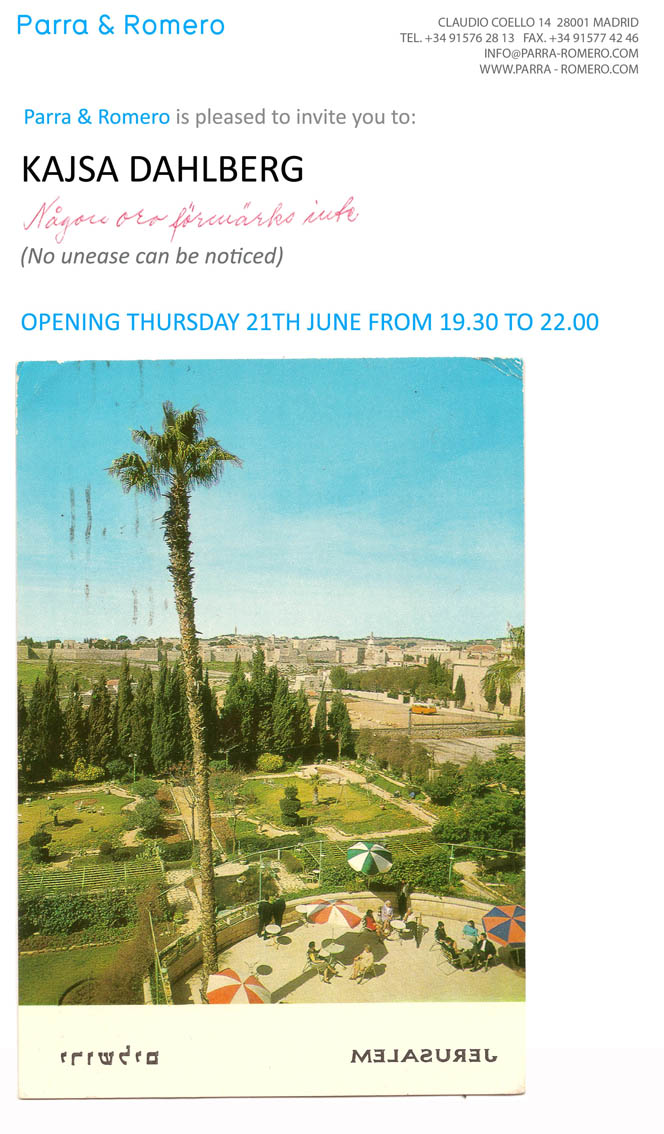

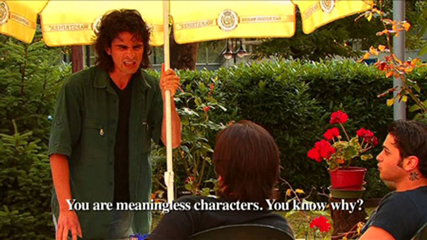
TELLING EVERYTHING, NOT KNOWING HOW
OPENING: JUN 2012
JUN - SEPT 2012
Curator: Martí Manen
Telling everything, Not Knowing How comes around to the view of narrativity with the intention of asking what can be done and what can be told from the art side, which role plays the emotion within the narrative and also which fiction, reality, political and social contents appear within the contemporary creation.
Art is a great plataform from which to explore narrativity. The pressumption of content we face when viewing an artwork enhances an emotional connection when narrating and explaining stories. Within the contemporary art fields there exists a willingness to explain, to establish a rather literary dialogue with the person viewing the artworks. But, at the same time, it appears to be necessary to ask ourselves the reasons, questioning the forms, investigating the genealogies and becoming conscious of the moment we live in order to observe what is happening in the communication field. The languages and the readings of art are constantly modified, each artist and each viewer alter the conception of what is an artwork, what is transmitting or how it is received. There are not strict rules, hence the poetic escaping possibilities are multiple. In a social context, where there is rather not space for the investigation of possibilities, understanding art as a place from where to build other forms is desirable. And, if we incorporate emotions as key element, the affection capacity is positivily altered.
Telling everything, not knowing how is shown as double format exhibition. On the one hand, the exhibition is displayed at CA2M with works which incorporate narrative possibilities as well as questioning the fact of how to explain. On the other hand, a novel written by the curator of the exhibition.
The novel embodies the complete set of works displayed in the exhibition, accompanied by others, within a plot which becomes the conceptual and discursive base of the project. Two characters from the book wander around their recently obtained maturity, after knowing the death of the Cuban-American artist, Felix Gonzalez-Torres, main reference in the incorporation of narration in art from an emotional, political and personal aspect, highlighting his willingness to share, without having to enter into the private side. The death of Felix Gonzalez-Torres is the starting point of a double journey structured by means of artworks. A novel which offers a kind of approximation different from the physical exhibition and it is, in fact, one of the pilars of the narrative. To make use (and to pervert) of the novel as exhibition venue allows working at once with the artwork as well as with information, with ideas and emotions, and with theory and practice. The writing of the novel stretches some roles to the limit: the curator makes use of the artworks from an absolute subjectivity aiming to create a narrative structure in fiction, the artworks become literary and reading material, visitors of the museum become readers, while the readers of the novel are tourning around an exhibition that take place within the book pages.
The novel, specially published for this project, is available both at CA2M as well as in bookstores.
The physical exhibition at CA2M presents a set of key works which will talk about narrativity and contemporary art, examples on how to explain, to deconstruct a story, to analyze and to work the characters, parallel readings to the documentary and what is understood as cinematographic, as well as a formal contact with literature and the definition of story.
A number of installations, film and video projects, photographies and text-based artworks coexist in a permanent dialogue where stands out the need to interact with the public.
ARTISTS
Eija-Liisa Ahtila (Finland), Rosana Antolí (Spain), Rosa Barba (Italy-Germany), Keren Cytter (Israel), Kajsa Dahlberg (Sweden), Lilli Hartmann (Germany- Great Britain), Rosalind Nashashibi / Lucy Skaer (Great Britain), Christodoulos Panayiotou (Cyprus), Job Ramos (Spain) and Alex Reynolds (Spain).
Publications
The project is presented in two interrelated formats: on the one hand, we have the exhibition with key works that open up various narrative possibilities and, on the other, we have a novel.
 I want a president... produced a Poster to RUSSIA.
I want a president... produced a Poster to RUSSIA.



.jpg)
.jpg)
.jpg)








 Under constructionUnder constructionUnder constructionUnder constructionUnder constructionUnder constructionThis website is.pdfThis website is.pdfThis website is.pdf
Under constructionUnder constructionUnder constructionUnder constructionUnder constructionUnder constructionThis website is.pdfThis website is.pdfThis website is.pdf




.jpg)


 Kajsa Dahlberg: Still from Reach, Grasp, Move, Position, Apply Force (2015). Photo is from The British Universities Film & Video Council.
Kajsa Dahlberg: Still from Reach, Grasp, Move, Position, Apply Force (2015). Photo is from The British Universities Film & Video Council.












![]() A Feminist Culture Reader undersøger den enorme indflydelse feministisk tænkning har, og har haft, på forskellige generationer af billedkunstnere, i et nationalt og internationalt perspektiv.
A Feminist Culture Reader byder på værker af kunstnere med vidt forskellige (feministiske) positioner, der hver især giver et indblik i eksistens set igennem køn, traume og (kunst)historisk materiale.
A feminist Culture Reader består af en solo udstilling af Peter Brandt, samt en gruppeudstilling i Danske Grafikeres Hus. I forbindelse med de to udstillinger vises en række satellit udstillinger rundt omkring i byen, der skaber en dialog om udstillingernes tematikker på tværs af institutioner.
Mer info: www.feministculturereader.dk
A Feminist Culture Reader undersøger den enorme indflydelse feministisk tænkning har, og har haft, på forskellige generationer af billedkunstnere, i et nationalt og internationalt perspektiv.
A Feminist Culture Reader byder på værker af kunstnere med vidt forskellige (feministiske) positioner, der hver især giver et indblik i eksistens set igennem køn, traume og (kunst)historisk materiale.
A feminist Culture Reader består af en solo udstilling af Peter Brandt, samt en gruppeudstilling i Danske Grafikeres Hus. I forbindelse med de to udstillinger vises en række satellit udstillinger rundt omkring i byen, der skaber en dialog om udstillingernes tematikker på tværs af institutioner.
Mer info: www.feministculturereader.dk











 2014 - 09 - 17
2014 - 09 - 17


 A week-long salon with 11 artists, curators and theorists at Skomvær Lighthouse organised by FRANK.
The salon was held at Skomvær Fyr in the Lofoten islands in Northern Norway, where Katarina Bonnevier, Liv Bugge, Malene Dam, Mathias Danbolt, Vika Begalska, Berivan Erdogan, Ester Fleckner, Jason Rosenberg, Sille Storihle, Elin Vister, Elijah Yakovenko and myself spent an amazing week together, sharing work and research. More at:
A week-long salon with 11 artists, curators and theorists at Skomvær Lighthouse organised by FRANK.
The salon was held at Skomvær Fyr in the Lofoten islands in Northern Norway, where Katarina Bonnevier, Liv Bugge, Malene Dam, Mathias Danbolt, Vika Begalska, Berivan Erdogan, Ester Fleckner, Jason Rosenberg, Sille Storihle, Elin Vister, Elijah Yakovenko and myself spent an amazing week together, sharing work and research. More at:  A a night walk during daytime through Tiergarten in Berlin on June 16 2014.
2014 - 04 - 10 - 2014 - 04 - 14
A a night walk during daytime through Tiergarten in Berlin on June 16 2014.
2014 - 04 - 10 - 2014 - 04 - 14
 Is It Really working? A Physical Symposium/Crash Course has recently taken place within the framework of my MA thesis project for the Master in Curatorial Studies at CCS Bard.
The symposium/crash course occurred between April 10th and 14th 2014 and comprised a series of closed and open conversations and workshops among artists and culture agents coming from different fields of artistic production. The idea was to gather around a discussion concerning the current conditions of culture production, with the current situation for artists, curators, and other art workers in the area of NYC as a starting point. The lenses through which we departed in our conversations is a sense of commitment to political positions informed by feminist and queer politics, with the constant problematization and questioning that such political affiliations entail.
The core group that was invited to participate in this experimental platform was formed by Vanessa Anspaugh, Malin Arnell, Amelia Bande, Gregg Bordowitz, Kajsa Dahlberg, Andrew Kachel and Alhena Katsof. Arnell and Dahlberg, despite not being directly invited with the allocated budget for my project, were able to participate since they were also part of my classmates shows, Carla Acevedo-Yates and Andrew Kachel. Through a form of informal collaboration between us, they all were able to take part in these conversations, informing with their thoughtful formulations of their experience, the scope of the problematics brought to the table.
2014 - 02 - 28
Is It Really working? A Physical Symposium/Crash Course has recently taken place within the framework of my MA thesis project for the Master in Curatorial Studies at CCS Bard.
The symposium/crash course occurred between April 10th and 14th 2014 and comprised a series of closed and open conversations and workshops among artists and culture agents coming from different fields of artistic production. The idea was to gather around a discussion concerning the current conditions of culture production, with the current situation for artists, curators, and other art workers in the area of NYC as a starting point. The lenses through which we departed in our conversations is a sense of commitment to political positions informed by feminist and queer politics, with the constant problematization and questioning that such political affiliations entail.
The core group that was invited to participate in this experimental platform was formed by Vanessa Anspaugh, Malin Arnell, Amelia Bande, Gregg Bordowitz, Kajsa Dahlberg, Andrew Kachel and Alhena Katsof. Arnell and Dahlberg, despite not being directly invited with the allocated budget for my project, were able to participate since they were also part of my classmates shows, Carla Acevedo-Yates and Andrew Kachel. Through a form of informal collaboration between us, they all were able to take part in these conversations, informing with their thoughtful formulations of their experience, the scope of the problematics brought to the table.
2014 - 02 - 28







_HEM.jpg)
bild_HEM.jpg)

 The Feverish Library (continued)
19 January – 23 February 2013
Opening Saturday 19 January, 6 – 8.30pm
Karl-Marx-Allee 45, 10178 Berlin, +49 30 2408 8130
info@capitainpetzel.de,
The Feverish Library (continued)
19 January – 23 February 2013
Opening Saturday 19 January, 6 – 8.30pm
Karl-Marx-Allee 45, 10178 Berlin, +49 30 2408 8130
info@capitainpetzel.de, 




.jpg)